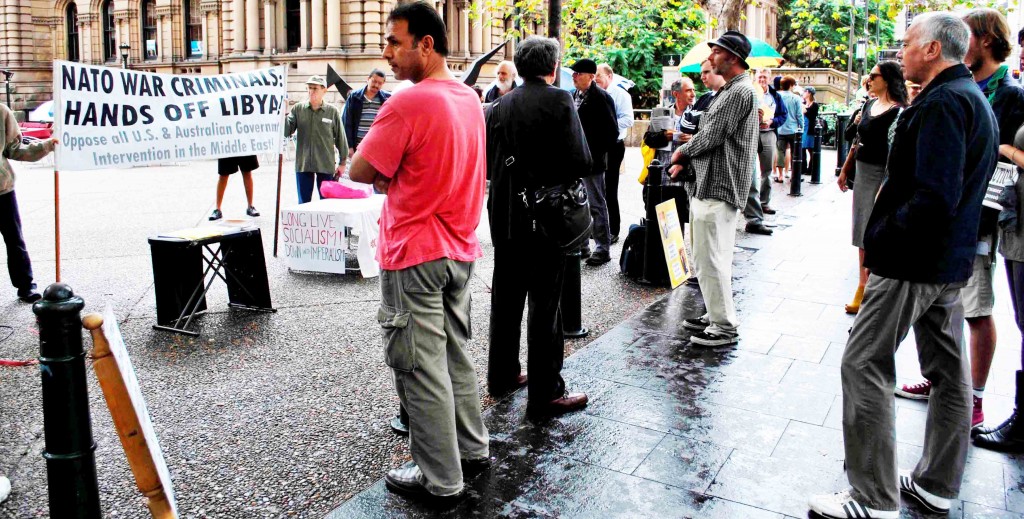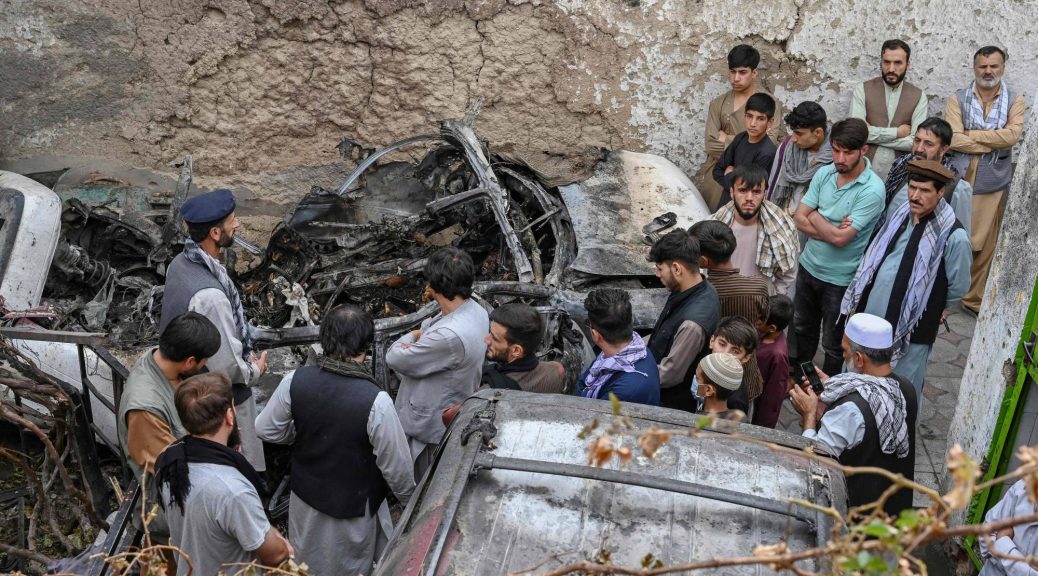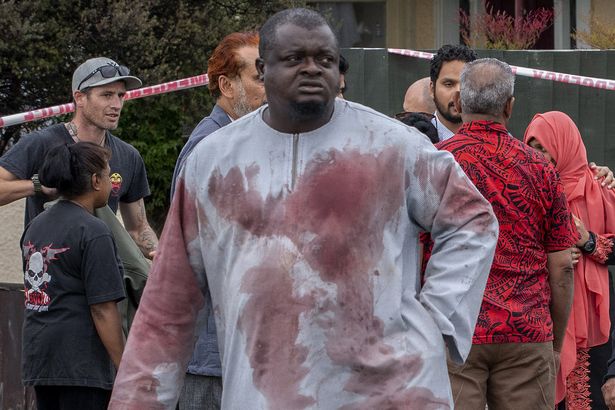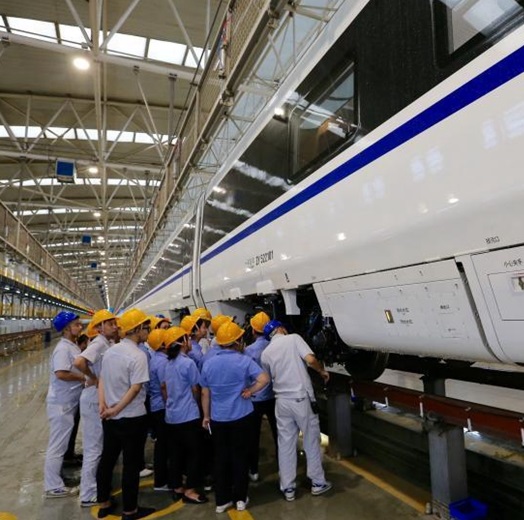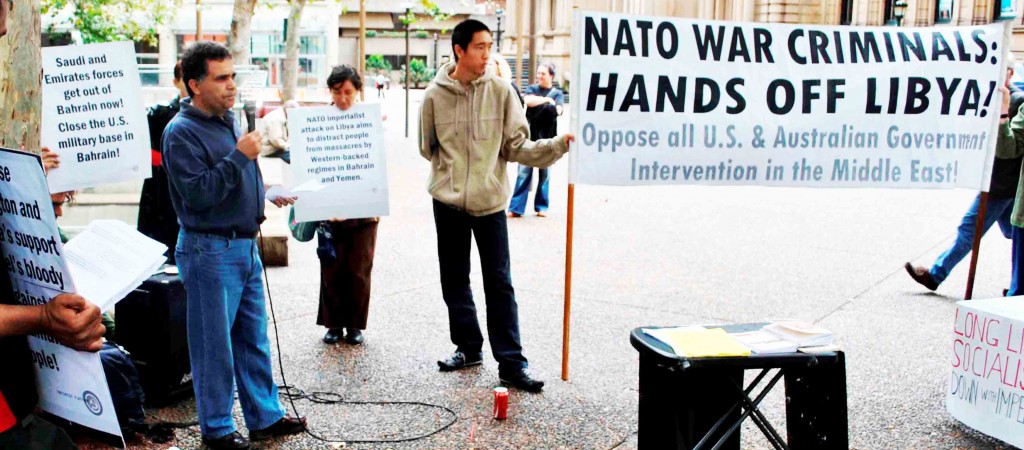Photo Above: Family members view the wreckage of a car destroyed in a U.S. drone strike on a residential neighbourhood of Kabul on 29 August 2021. The U.S. attack killed ten civilians including an employee of a U.S.-based aid organisation as well as seven children – the youngest being two, two year-old girls. The U.S., British, Australian, French and German imperialists killed tens of thousands of Afghan civilians during their invasion and occupation of Afghanistan. Russia’s and Ukraine’s ruling classes are certainly oppressive capitalist exploiting classes. But it is the U.S., British, Australian and other Western ruling classes that are the world’s biggest bullies and the ones that are subjugating most of the world’s people.
Photo credit: Wakil Koshar – AFP
Bougainville, Iraq, Somalia, Serbia, Afghanistan, Libya, Syria, Pakistan, Yemen, Palestine:
Victims of U.S., Australian, NATO and Allied War Machines
The Main Threat to the World’s People and the Main
Enemy of the Australian Working Class is Not Putin’s Ambitious
Capitalist Regime But the U.S., Australian and Other Western Imperialists
OPPOSE WESTERN IMPERIALISM’S PROVOCATIVE AND HYPOCRITICAL
INTERFERENCE IN UKRAINE AND OPPOSE SANCTIONS AGAINST RUSSIA!
NO TO NATO EXPANSION! NO U.S./AUSTRALIAN ARMS TO UKRAINE!
FOR UNITY OF THE RUSSIAN AND UKRAINIAN WORKING CLASSES
AGAINST BOTH THEIR CAPITALIST RULERS!
Stop Morrison and Albanese from Escalating Their War Drive against Socialistic China!
9 March 2022: Thirteen days ago, Russian troops began an operation with the stated aim of supporting Russian-speaking rebels in the Donbass region of Eastern Ukraine. The rebels have waged an uprising in the districts of Donetsk and Luhansk ever since right-wing nationalists in Ukraine seized power in a 2014 coup and unleashed language discrimination and ethnic terror against the Russian-speaking peoples of the Donetsk and Luhansk districts (known collectively as the Donbass). The rebels have increasingly called for independence for these districts from their Ukrainian oppressors. On 21 February, Russian president Vladimir Putin announced that Russia was recognising the independence of Donetsk and Luhansk. Now he is enforcing that with military intervention and extending Russian forces into whole swathes of Ukrainian territory.
It is not yet known what the Russian administration’s final goal is. However, what is clear is that part of Putin’s agenda is to prevent Ukraine from becoming a staging post for NATO troops and nuclear missiles aimed against Russia. Ukraine had been working toward joining NATO. Russia’s use of military might in a way that has impinged on the sovereignty of one of NATO’s allies and trampled on the interests of Western imperial powers has horrified Western leaders. They are, after all, so used to being the ones that use violence to bully others into submission! Now they are getting a taste of what they have been dishing out to hundreds of millions of people over the years. Indeed, certain reports coming out of Ukraine, like the one that Russia’s incursion had caused the embassy staff representing the Canadian imperialist regime to flee the country in tears, would have triggered celebration among anti-imperialists around the world. Many know all too well how the Canadian imperialists, their senior partners in the U.S. and their other imperialist allies – like the Australian regime – have been brutally riding roughshod over large numbers of the world’s people with almost complete impunity. It is nice to see their interests now being harshly violated! However, there is another side to Russia’s intervention. Although in part a pre-emptive defense measure against NATO, Russia’s capitalist rulers also seek to advance their project to establish a capitalist sphere of influence over the territories of the former USSR. Moreover, in both the actions of Russia which is pushing further into Ukraine than just the majority ethnic-Russian areas and those of Ukraine, which refuses to recognise the right to self-determination of majority Russian areas in the Donbass, the innate capitalist drive to maximise the size of secure markets by maximising territory is all too evident. The imperialist-backed, Ukrainian capitalist regime that brutally persecutes the ethnic Russian people in the Donbass and the ambitious Russian capitalist regime are fighting a reactionary war on both sides. A war that is causing much suffering and death.
Russia’s actions have been denounced by the U.S. rulers and their European NATO and Australian allies. These Western regimes have imposed stiff new sanctions on Russia. The Australian imperialists are eagerly part of these moves. The right-wing Liberal government and the Labor opposition have been tripping over each other to be the first to advocate ever more provocative actions against Russia. Meanwhile, Western capitalist leaders have reiterated their “right” to provocatively extend NATO to Ukraine to further encircle Russia. They are also sending even more military hardware to their Ukrainian allies. This includes Javelin hand-held anti-tank missiles and Stinger hand-held anti-aircraft missiles. Three days ago, Australian prime minister, Scott Morrison boasted that, “Our missiles are on the ground now [in Ukraine].” In other words, the U.S., European and Australian imperialists are pouring even faster into the cauldron the very same fuel that ignited the conflict in the first place.
In lockstep with his senior partners in Washington, Morrison ranted that Russia’s rulers are “thugs and bullies.” Ever eager to prove his loyalty to the U.S.-Australia alliance that Australia’s capitalist bigwigs insist on, ALP leader Anthony Albanese joined in too, denouncing Russia as the “aggressor.” So did the Greens. The following day, Morrison condemned Russia for an “unprovoked and “brutal invasion”. Hang on! Is it not the U.S. and Australian regimes that conducted a completely unprovoked and heinously brutal invasion of Iraq in 2003 in the course of which they killed hundreds of thousands of Iraqi civilians? Interviews by Australian regime-controlled media, like the ABC, with understandably worried residents in Kiev only highlights that these media never broadcast such interviews from Iraqi cities when the U.S./Australian/British imperialist forces were terror bombing the people of that country during their 2003 invasion; or during their earlier 1991 assault on Iraq.
Alongside their first 1991 attack on Iraq the, now known as, AUKUS powers spearheaded the enactment of severe United Nations economic sanctions on the people of Iraq. Those sanctions would end up causing the premature deaths of over 1.7 million Iraqi children from a lack of medicine and adequate nutrition! Yet it is hardly only in Iraq that the Western capitalist regimes have acted as “thugs and bullies.” In 1989, Canberra directed and armed PNG to carry out a brutal war against rebels on the island of Bougainville who had risen up against the arrogant destruction of their land by Australian-owned mining giant CRA (now part of Rio Tinto). Australia sent “ex-”SAS mercenaries to fly helicopter gunships. These Australian pilots unleashed some of most hideous massacres of Bougainville civilians. Canberra then helped impose a murderous blockade of the island to starve the people into submission. All up some 15,000 to 20,000 people in Bougainville were killed as a result of the thuggery of Australian imperialism.
Then in 1999, Australian regime forces led a military occupation of East Timor – supposedly to protect people from pro-Indonesian forces that had been staging brutal attacks. But Canberra’s real aim was to establish a political order in East Timor that would allow Australian companies to exploit Timorese labour and loot its rich gas resources. When the East Timorese government nevertheless resisted Australian demands to hand over its oil and gas wealth, the Australian regime planted covert listening devices in the Timorese prime minister’s office so that they could gain the advantage in negotiations over the division of Timor’s seabed gas resources. Then as the East Timorese government continued to not be subservient enough, Canberra again sent in “peacekeepers” in 2006 to manipulate events so that the then government would be overthrown in a coup and replaced by one more compliant to Australia’s capitalists. If that is not “bullying”, we don’t know what is!
Earlier in 1993, again under the guise of “peacekeeping,” the U.S. and Australia sent troops to Somalia to exert their influence over the strategic horn of Africa region. In doing so they unleashed brutal and often racist terror against the local people. It is only the brave resistance of the Somali people, who managed to bring down several U.S. helicopter gunships that finally saw an end to the occupation. Then in 1999, NATO unleashed a 78 day bombing campaign against Serbia, killing thousands of civilians as their bombs and missiles struck apartments, civilian buses, factories, refugee convoys, a packed civilian passenger train and most notoriously the Chinese embassy in Belgrade. Two years later, the U.S., backed by Australia, New Zealand, Britain, Germany, Canada and France and other NATO countries, invaded Afghanistan. They callously killed 30,000 Afghan civilians – mostly through “accidental” air strikes on wedding parties, hospitals and homes. The Australian regime’s SAS special forces committed many of the worst war crimes. They murdered unarmed Afghan peasants, tortured and executed prisoners and slit the throats of young boys. One of their worst atrocities was their 15 December 2012 massacre of at least thirteen Afghan onion farmers and their children. The Australian forces unleashed this massacre after an SAS patrol commander “accidentally” shot one of the farmers and then the patrol decided to murder all the witnesses to cover up the initial crime.
In the middle of their brutal twenty year occupation of Afghanistan, Western forces invaded Libya and overthrew the Gaddafi government there for the “crime” of refusing to totally align his policies with their predatory designs over Libya’s and Africa’s economy. The Pine Gap, U.S./Australia joint spy base in Australia’s Northern Territory worked over time to pinpoint NATO’s air and missile strikes in Libya. The Australian-backed NATO invaders ended up killing tens of thousands of Libyan civilians. They imposed a regime change that not only resulted in ten years of bloody infighting amongst NATO’s puppets installed into power but triggered the racist slaughter of thousands of black-skinned Libyans and migrant workers from Chad, Niger, Somalia and Nigeria. To all this we must add Western imperialism’s proxy war on Syria which killed hundreds of thousands of people, the mid-2010s U.S./British/Australian bombing campaign over Syria and Iraq which killed over ten thousand more innocent people in “accidental” air strikes, the killing of thousands of civilians in U.S. drone strikes in Northwest Pakistan, America’s provocative assassination of a top Iranian general in January 2020, the tens of thousands made to die prematurely as a result of starvation Western-initiated sanctions on the people of North Korea, Iran, Syria and Venezuela, Israel’s Washington and Canberra-backed genocidal terror on the Palestinian people and Saudi Arabia and the Gulf states’ terrifying U.S.-orchestrated war in Yemen. Meanwhile, here in Australia, the sovereignty and rights of Aboriginal people continue to be brutally crushed by Australia’s racist ruling class.

During their occupation of Afghanistan, the U.S., British, Australia, French and German imperialists repeatedly chose to attack targets that they knew had a high probability of actually being civilians or in which they knew civilians could get killed in the course of the attack. For the Western imperialists the lives of darker-skinned peoples, especially those living in the “Third World” are expendable.
So for the Western regimes to now condemn Russia for violating the sovereignty of another country is the vilest hypocrisy. For them to claim that Russia’s operation in Ukraine has disrupted an otherwise “peaceful world order” is the most revolting lie. Tell that to the people of Iraq, Afghanistan, Libya, Somalia, Palestine, Yemen, Pakistan, Serbia, Bougainville, Iran, Syria, etc, etc! The fact is that the U.S., British, Australian, German, Canadian and French regimes disrupt world peace and make new violations upon the sovereignty of other countries more frequently than most people change their toothbrushes! And they have been unleashing air or ground attacks on peoples around the world more often than we clean our teeth! What is driving their murderous actions is neither sadism nor irrationality, although the capitalist system certainly does attract into leading positions irrational and sadistic people. Rather, the actions of these Western regimes flow quite logically from their roles as enforcers of the interests of the capitalist big business owners of their respective countries. In capitalism’s current, final phase, the capitalists of the richest countries not only exploit their own workers but exploit at an even more severe rate the toiling classes of the poorer countries, while plundering the natural resources of these countries and grabbing control of markets there. It is not a choice of these capitalists of the richer countries whether or not to act in this imperialist way. For them it is a necessity. The capitalist system at its advanced stage has outgrown national boundaries. Unless the capitalists of the wealthier nations engage in this imperialist robbery of the poorer countries, capitalist economies will implode under the weight of their own internal contradictions.
We should add here that being a big country with a powerful army that sends it forces abroad does not necessarily make one an imperial power. India for example, with its huge army and aggressive capitalist ruling class, is not an imperialist country but remains a semi-colonial victim of imperialism, thoroughly exploited, manipulated by and financially subservient to the real imperialists. Imperialism rather means the capitalists of the richer countries super-exploiting the masses of the ex-colonies in Asia, Africa, the Pacific, the Middle East and South and Central America through the export of capital and by using the threat of cutting off access to capital, markets and technology as a means to blackmail the peoples of the poorer countries into submission. It also means the regimes that serve these rich country capitalists unleashing horrendous violence against the peoples of their neo-colonies and semi-colonies in order to enforce this robbery.
Russia’s capitalist rulers dream of using their military and technological strength inherited from the Soviet Union to once again become a fully-fledged imperialist power, as they were in Tsarist times. Yet, although future events could change this, currently, Russia’s capitalists don’t quite yet have the economic strength or the capital provided by a richer imperial ally to seriously displace Western capital from their domination over the “Third World”. Right now, it is not Russia, but the U.S., Britain, Australia, France, Germany, Canada and their ilk who are the thugs bullying and exploiting much of the world’s people. Over the last 33 years, these Western capitalist regimes – and their Saudi and Israeli allies – have together killed more than FOUR MILLION people around the world through imperialist invasions, terror bombing, proxy wars, war crimes, drone strikes and sanctions. When the Western powers interfere into the current conflict in Ukraine by increasing military aid to Ukraine, imposing sanctions on Russia and bullying diplomacy, it is with the sole purpose of fortifying this bloody tyranny over much of the world. In particular, by punishing Russia – and in the process causing great suffering to her people through economic sanctions – the Western imperialists want to send a message to both Russia and other powers that no one should ever again dare to take any military action that harms their interests. We should not allow the U.S., British, Australian and other Western imperialist regimes to in this way reinforce their supremacy over the world and their monopoly over the use of violence in international relations. We should not allow them to pour more oil on the flames of the bloody conflict in Ukraine. The working class of the world, the billions of people suffering under Western imperial domination and all opponents of imperialism must demand: Western imperialism stop your aggressive intervention into the Ukraine conflict! No to your sanctions on Russia! Stop your flow of arms to Ukraine! Down with your plans to extend NATO eastwards! Down with NATO! Down with your schemes to seize on this war to whip up a “national security” obsession at home so that you can escalate your Cold War drive against socialistic China! We must understand that it is only the Russian and Ukrainian working classes who can end this war in a progressive manner by uniting with each other against each of their own aggressive capitalist ruling classes.
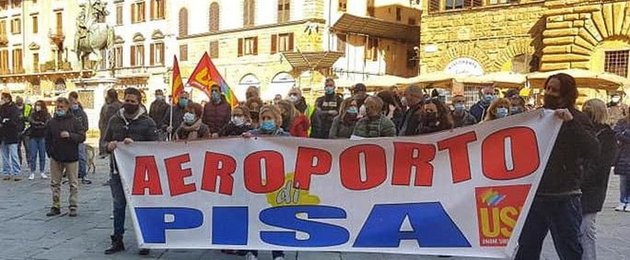
The Main Enemy is the Capitalist Ruling Class At Home
To understand that the Western capitalist ruling classes are by far the biggest oppressors of the world’s peoples does not mean that we need to prettify Russia’s capitalist ruling class – nor Ukraine’s. Putin and Zelensky can be thought of as the Scott Morrisons or indeed the Peter Duttons of Russia and Ukraine. However, unlike Morrison, Putin does not represent a regime that is part of the most powerful imperialist bloc in the world. Moreover, as nasty as the Russian capitalist ruling class is, it is not the main enemy of the working class and oppressed of Australia. The reason that 300,000 people were homeless in Australia at some point during last year is not because of Putin but because anti-working class Australian governments have sold off so much public housing that rental accommodation has become ever more unaffordable for lower-income workers and unemployed workers. It is telling too that just four days before Morrison ranted that Russia’s rulers were “thugs and “bullies”, yet another Aboriginal youth died as the result of a police action in Australia. Sixteen year-old electrician apprentice, Jai Wright, was killed in inner city Sydney after the trail bike he was riding was hit by a police car. The killed youth’s family have exposed how the police have told them two completely contradictory stories about how the crash occurred. The death of Jai Wright is showing all the hallmarks of the notorious 2004 police murder of 17 year-old Aboriginal youth, TJ Hickey, who was killed not far from where Jai Wright was hit when he was rammed by a police vehicle sending him flying onto a fence that impaled him. Since 1991, over 500 Aboriginal people have died in state custody. Many of the victims, like TJ Hickey, Mulrunji Doomadgee and David Dungay, were simply murdered by racist cops or prison guards. And the rivals of Australia’s ruling class thousands of kilometres away in Russia have nothing to do with these atrocities. These are wholly the crimes of the racist, rich people’s regime right here… the same one that has today been sanctimoniously attacking Russia!
It needs to be pointed out too that even as Australia’s rulers shed crocodile tears over the suffering brought by the war in Ukraine, here they have caused nearly 3,300 people to die from COVID in 2022 alone because they callously allowed COVID to rip while undermining testing and tracing services. This cruel policy, driven by their intent to put the interests of capitalist business owners above the welfare of the masses, has disproportionately hit low-paid frontline workers and their families – many of whom are from Middle Eastern, Asian and African backgrounds. In pursuing this profits-first policy, Australia’s ruling class has caused dozens of times more people to die from COVID here in 2022 than the number of civilians who have thus far perished in the bloody conflict in Ukraine.
However, there has also been resistance against the oppressors at home. Angered by the fact that their wages have barely risen while prices have surged, workers have waged more strike action over the last year than in quite a while. And with the NSW Liberal state government refusing to hire enough workers to staff key public sector roles, the last few months has seen nurses, rail workers, bus drivers and teachers unleash a wave of industrial action. However, such resistance will be weakened and the authority of the increasingly distrusted, rich people’s regimes will be restored to the extent that working class people buy the lie that they need to unite with the capitalist rulers against supposed external foes – in Russia and socialistic China. If the masses fall for this swindle, it will enable the capitalist regime to attack working class and other progressive struggles as “unpatriotic acts” that “endanger national security.” We will then see more outrages like the one unleashed by NSW transport minister, David Elliot, two weeks ago when he accused rail workers of “terrorist-like activity” for merely engaging in low-level industrial action. That is why politically aware workers must convince their co-workers that the main enemy of working class people here is not far away in Moscow but is rather the capitalist ruling class right here. They must explain that we should NOT unite with this Australian ruling class to defend “national security.” When the ruling class talk “national security” they only mean the “security” of their predatory interests and their capitalist system of exploitation. So rather than being sucked into helping our exploiters and oppressors fight their overseas foes, let us wage class war against these capitalist exploiters! Let’s fight for big wage rises, for a guaranteed minimum wage and all the rights of permanency for all gig and casual workers, for a massive increase in public housing, for union action to oppose racist state terror against Aboriginal people and for the rights of citizenship for all guest workers, international students and refugees.
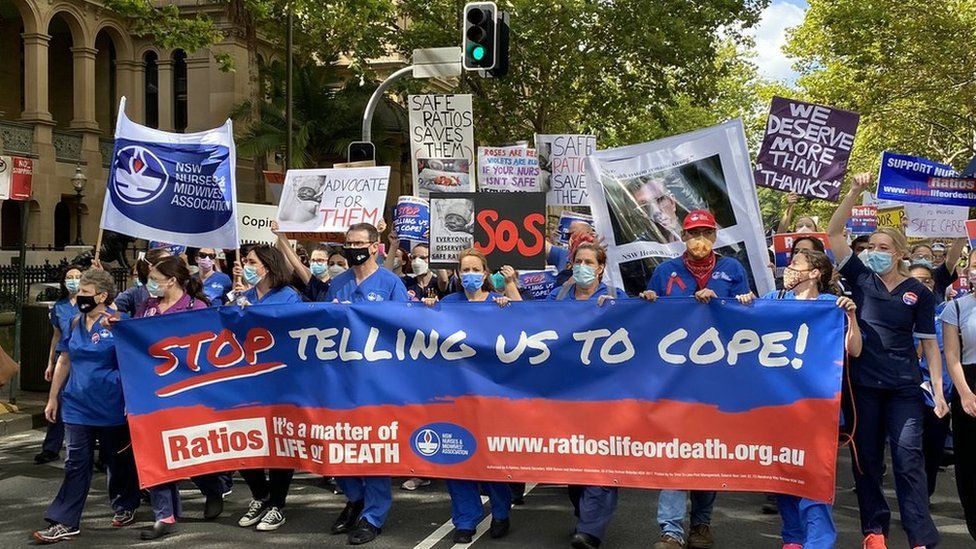
The Roots of the Conflict in Ukraine
The 1991-92 capitalist counterrevolution that destroyed working class rule in Russia and the other lands of the former Soviet Union (USSR) was thoroughly backed, and indeed brains trusted, by U.S. imperialism and allies. Therefore, these Western powers had enormous sway over the new capitalist states that emerged over the lands of the former USSR. To be sure, given the enormous economic development and technical progress of the peoples of the region during Soviet times, the Western imperialists were not able to turn these countries into neocolonies that are plundered in the same way that, say, Australian capitalists rob the people of PNG and East Timor today or the way that American, Japanese, British and Australian capital super-exploits the toiling classes of Indonesia and the Philippines. Nevertheless, Washington and to a lesser extent other Western regimes grabbed control of the markets in these countries, dictated to the fledgling new capitalist leaders, forced them to implement privatisation schemes even more rapidly than even they wanted and treated the peoples of these countries in a patronising way. In some ways the relationship between the Western powers and the countries of the former USSR was like the relationship between the U.S. and, say, South Korea, which is not a superexploited economic semi-colony of Western imperialism but is nevertheless dictated to and bullied by Washington.
For the first decade after their restoration to power, the capitalist rulers in the biggest and most powerful of the ex-Soviet countries, Russia, grudgingly accepted this subordinate status. However, after they stabilised their rule and after surging oil prices at the start of 21st century flushed these rulers of oil-rich Russia with new wealth, Russia’s capitalist rulers began to push back against high-handedness from Washington and her European NATO allies. Moreover, Russia’s increasingly ambitious rulers began to pursue their dream of becoming the imperialist top dogs of the ex-Soviet region. Washington and the West European imperialists resisted this new-found assertiveness of their former Russian underlings. They sought to push Russia’s down into the subordinate status that it had during the 1990s. This sharp clash over what Russia should be, between on the one hand, the U.S.-led drive to return her to being a patronised, Western-dependent country and on the other, the Russian ruling class’ ambitions to become a new imperial power, is the underlying conflict from which arises all disputes between the NATO powers and Russia’s rulers.
The Western mainstream media have very inaccurately portrayed the project to restore Russia’s Tsarist imperial “glory” as a personal project of Putin. In fact, it is an ambition supported by the majority of Russia’s capitalist class. That is why Putin’s military intervention into Ukraine was overwhelmingly supported by the Russian parliament. The change in attitude of Russia’s ruling class did not come with Putin acquiring the presidency in 1999. It is worth noting that in the mid and late 1990s, Putin was a loyal functionary of then president Boris Yelstin, when the latter ran an administration that accepted Russia’s subordinate position to the U.S. and Germany. What changed was not Putin but the economic and political conditions – not least the world oil price.
Being a country that is not at this stage a fully-fledged imperialist power, there remains a wing of the Russian capitalist class that thinks that their interests would be better served if Russia were to again become a subordinate partner to the NATO powers. Today, many in this wing of the Russian elite support the prominent Western-backed opposition figure, Alexei Navalny. The Western media would like to portray Navalny and other pro-Western forces as “liberals” as opposed to pro-Putin “authoritarians”. However, the pro-Western wing of the Russian capitalist class is not necessarily more “democratic” than the dominant, independent wing. If the pro-Westerners make demands opposing government censorship it is largely only because they are out of political power and want more space to gain the ascendancy. But it is very important to note that Navalny has marched in extreme right-wing anti-immigrant marches and has demanded in the past that migrants be deported from Russia. Hardly a true “liberal democrat”!
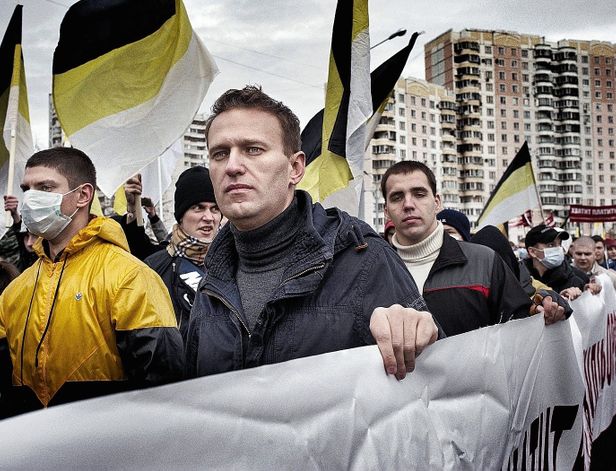
Western ruling classes are also divided about what attitude they should take towards Russia. In the U.S. there is a wing of the capitalist class that believes that Washington should accommodate to a degree Moscow’s concerns and ambitions. They hope for a U.S.-Russia capitalist super-power alliance against their main enemy: socialistic China. They also see the possibility of using Russian military might as a counter-weight to the economic strength of their German and French allies cum competitors. This is the agenda that hard right former U.S. president Donald Trump originally wanted to pursue but was blocked by a wall of opposition from other wings of the American capitalist class. Even Biden, when he first took office, signaled the possibility of improving U.S. relations with capitalist Russia in order to isolate the Chinese workers state. However, moves to improve Washington-Moscow relations became unstuck because capitalist economic realities drove the two regimes apart. Especially given the growing contradictions in capitalist economies and now hit by COVID, the American and other Western capitalists need to increasingly exploit the poorer countries and further dominate their markets. They simply cannot allow a new imperial power to emerge and contest for the markets and resources that they have so jealously apportioned for themselves. Meanwhile, Russian capitalism with its own economic woes cannot afford to see itself being further displaced by Western capitalists from the huge market for its exports that existed in Ukraine and other former Soviet lands. Thus, although it is not impossible that capitalist enmity to socialism could in the future still unite Washington and Moscow into a grand capitalist alliance against Red China, right now, like the inevitable clash between existing Mafia godfathers and a new kid in the block gang that they seek to contain and subordinate, the conflict between the most powerful Western imperialist robbers and their emerging Russian rival has reached breaking point.
Ukraine has been a key battleground of this clash. In the 1990s when Russian capitalism was subordinated to the Western powers, Washington, Berlin, Paris and London were relatively content to allow Kiev to have amicable relations with Moscow. However, as Russia became more independent and self-confident during the 21st century, the Western powers pushed for Ukraine to move away from Russia and give them prized access to the Ukrainian market for their exports. As a result, the issue of whether Ukraine should be more closely aligned with, on the one hand, the U.S. and Europe or, on the other, Russia, became the defining issue in Ukrainian political life. At the 2002 parliamentary elections, parties favouring closer ties with Russia were voted in. Two years later, despite blatant interference by Washington in support of the pro-Western candidate, the pro-Russia candidate Viktor Yanukovych won presidential elections. However, spurred on by Washington, the defeated forces challenged the validity of the results through street protests. The parties and NGOs leading these protests were funded directly by the U.S. government and its various agencies like Freedom House as well as by pro-imperialist American “NGOs”. Meanwhile, these American agencies and NGOs provided training on rebellion tactics to their Ukrainian allies. The U.S. campaign in the end succeeded. In a coup, dubbed the “Orange Revolution”, Yanukovych’s election victory was annulled and the pro-Western candidate arose to the presidency. However, at subsequent elections, the parties brought to power by the Washington-backed “Orange Revolution” were voted out by the people. Ukrainian administrations became a revolving door as neither the pro-Western wing of the capitalist elite nor its pro-Moscow wing could satisfy the aspirations of the masses.
In late 2013, then president Yanukovych backed away from signing an agreement for closer integration with the European Union. Ukraine had asked the EU for a loan to make up for the cost of making changes to her economy required by the agreement. The EU and the IMF demanded that Ukraine implement neoliberal changes to her economy as the price for any loans – such as removing gas subsidies. Fearing unrest from implementing such policies, the Yanukovych administration instead looked towards closer ties with Russia, Belarus and Kazakhstan. Pro-Western parties responded with a campaign of street protests that were again funded and “advised” by U.S. government agencies and NGOs. They were aided in mobilising these protests by widespread anger at the government over rampant corruption and falling living standards. This was the “Orange Revolution” Version 2. However, things were different this time around. The U.S. involvement was even more overt. Especially with their own economy weakened following the Great Recession, the American ruling class really needed to get a greater share of the Ukrainian market, which at that time was still dominated by exports from Russia. Meanwhile, the polarisation within Ukraine had also become more intense. Nourished by this polarisation and the ongoing misery caused by the late noughties recession, the far-right had become a major factor in Ukraine. The main activist force behind the anti-government movement, dubbed Euromaidan, was now the extreme right-wing Svoboba Party, an outfit that espouses hatred of Russians, Jews and immigrants. Forming the shock troops of Euromaidan was the even more extreme Pravy Sektor (Right Sector), a neo-Nazi paramilitary group which had already become notorious for attacks on international students and immigrants. As a result, by early 2014, the “protests” became increasingly violent. Rioters assaulted – and in some cases murdered – opponents of the movement. The increasingly influential fascist factions opposed any compromise deal with Yanukovych. As a result, Yanukovych was deposed. His administration was replaced by a coalition dominated by right-wing conservatives and the fascistic Svoboda party. What happened in early 2014 was like last year’s January 6 far-right uprising in Washington, with the crucial difference that in Ukraine the right-wing forces actually triumphed. For the second time in a decade an elected Russia-friendly president in Ukraine had been overthrown in a U.S.-backed coup.
Popular Sentiment in Eastern Ukraine and Russia against the Euromaidan Regime
After the Euromaidan coup, Ukraine became even more polarised geographically between the West of the country and the South and East of Ukraine, with its high percentage of Russian speakers and minorities. In the West, the mood was pro-Western and Ukrainian nationalist, with the areas being strongholds of the pro-EU conservatives and the Far Right. The South and the East of Ukraine, however, wanted closer ties with Russia and supported Yanukovych’s Party of Regions or the Communist Party of Ukraine. This polarisation deepened still further when just two days after the coup, the new nationalist government voted to repeal a language law that allowed Russian – and in some smaller areas Hungarian, Moldovan and Romanian – to be used as a regional second language in schools and government institutions in those areas where there is a high proportion of speakers of these languages. This repeal, the coup toppling the pro-Russian president, violent attacks on opponents of the anti-Russia forces during Euromaidan and the presence of extreme anti-Russian figures in the new regime led to angry protests in the South and East. In the Crimean Peninsula, where the population was overwhelmingly Russian, large demonstrations started to call for withdrawal from Ukraine and accession to Russia. Then following a referendum where Crimea voted 95% for seceding from Ukraine and joining Russia – with an 83% voter turnout – Russia annexed Crimea.
In the majority Russian-speaking Donetsk and Luhansk districts, the Euromaidan coup triggered a rebellion against the new regime. This was met with brutal repression by the Ukrainian military and far-right volunteer paramilitary organisations. Many of the latter have been funded by Ukrainian oligarchs, like Ukraine’s second richest billionaire, Ihor Kolomoyskyi. Most prominent among these paramilitaries is the Azov Battalion. As well as recruiting Ukrainian right-wing extremists, Azov has been a magnet for white supremacists from Sweden, Spain, the U.S., Croatia and Italy. Azov has conducted brutal attacks on leftists and minorities – especially targeting Roma people. Within Donetsk and Luhansk, Azov and the other fascist paramilitary outfits have committed the most horrific atrocities including murdering civilians and raping and torturing detainees. These crimes have hardened the resolve of the Russian-speaking rebels. Initially they mostly demanded greater autonomy. Now, most of the ethnic Russians – and even many Russian-speaking ethnic Ukrainians – in these districts want independence.
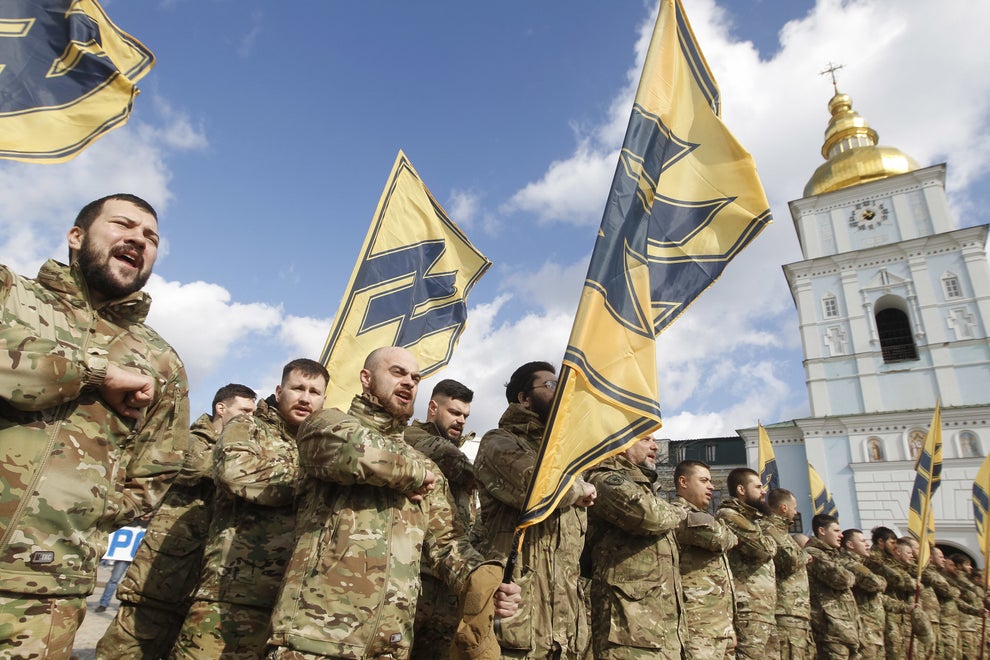
The struggle for self-determination of the Russian-speaking people of Donetsk and Luhansk is a just struggle, in essence similar to the Palestinian people’s struggle, the Tamil struggle for national self-determination in Sri Lanka and struggle for independence of the people of West Papua. It is also somewhat different to these struggles in that in the case of the Donbass, adjacent to the people demanding self-determination exists, in the form of Russia, a powerful neighbour dominated by a people based on the same ethnicity/language group. As a result there is a Russian chauvinist strain within the rebellion. Worryingly, Russian rightwing extremists from outfits like the Russian National Unity group have come from Russia to join the movement and some of these fascists have also committed attacks on Roma. Additionally, the Hungarian neo-Nazi Jobbik Party, the Serbian far-right, anti-communist Chetniks and the fascist British National Party are also backing the Donbass rebellion and Australian white supremacist parties have given moral support. At the same time, it should be noted that the fascist component of the Donbass rebellion seems smaller than in the Ukrainian paramilitary irregulars opposing them. Moreover, given the just character of the Donbass people’s demands, leftist groups have also formed a component of the Donbass uprising.
Other than the issue of language and ethnic persecution, there is another aspect to the hostility to the Kiev regime within the East of Ukraine. Not only is the East, where ethnic Russians mix together with both Russian-speaking and Ukrainian-speaking Ukrainians, Belarussians, Jews and Greeks, more cosmopolitan than the West of the country, its population has a higher percentage of wage workers – especially blue collar workers – due to the area being more industrialised. As a result, a large chunk of the population there has sympathy for socialism and is nostalgic for the much better life that they had in Soviet times. Therefore, when the post-Euromaidan regime began knocking down monuments to the Soviet Union and to the Red Army’s heroic victory over Nazi Germany, this provoked outrage amongst many in Eastern Ukraine. This sentiment was reinforced, when in 2015, the Ukrainian regime despicably made two Nazi-collaborating, anti-Soviet Ukrainian paramilitary groups (the UPA and the OUN), “heroes of Ukraine.” During World War II, the UPA and OUN between them murdered 100,000 Polish people and tens of thousands of Jewish people, while helping their Nazi allies to carry out the Holocaust.
Through the many family and other personal connections that people in the East of Ukraine have with those in Russia, their hostile feelings towards the Ukrainian regime became known to people inside Russia. Meanwhile, reports of the atrocities committed by the Ukrainian military and especially its far-right paramilitary auxiliaries against Russian-speaking people caused disgust within Russia. As a result, although Putin’s decision to unleash the Russian military against the Ukrainian regime reflects the interests of the Russian capitalist class that he serves, Putin was, to some degree, egged on by popular hostility to the Kiev authorities amongst some Russians.
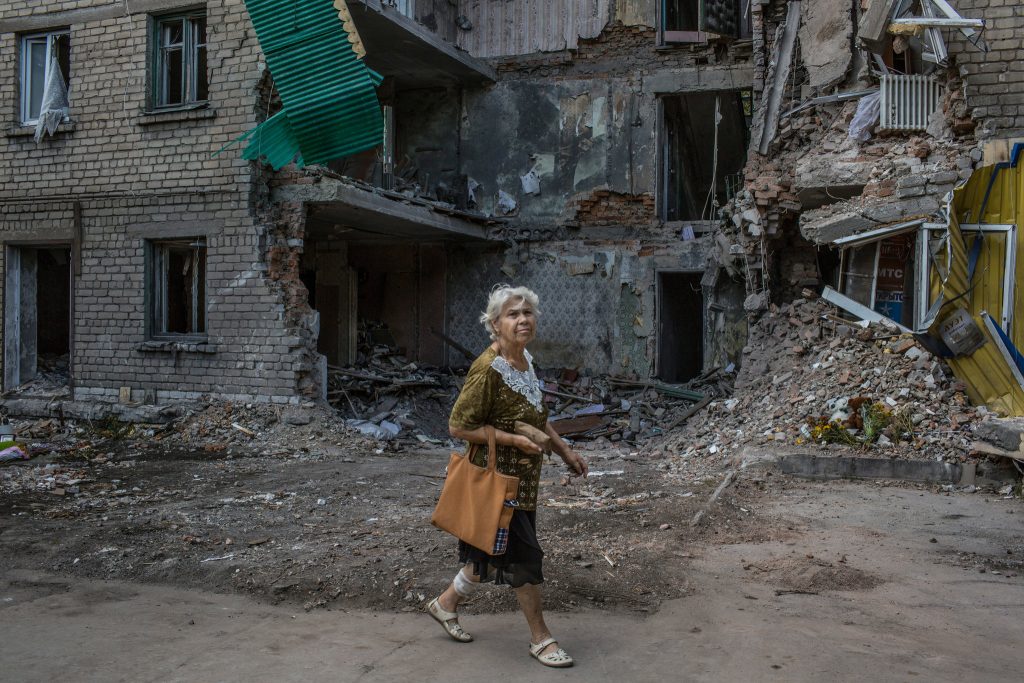
Photo Credit: Mauricio Lima
Washington Provoked This Conflict
The weeks leading up to the Russian intervention saw meetings between Russian and Western leaders. The main issue was Russia’s demand that NATO give guarantees that it would not expand further eastwards into Ukraine, that is, not expand right up to Russia’s western border. Russia, quite understandably, sees that prospect as threatening. As part of the then Soviet Union, the people of Russia lost some 20 million of their compatriots when Germany invaded the Soviet Union from the west during World War II. Washington and the mainstream Western media denounced Russia’s demands saying it is outrageous and unprecedented for a government to be demanding that a government of a neighbouring country not undertake the security arrangement of its own choosing. Unprecedented? Really? Well in October 1962, then U.S. president John F. Kennedy came within a hairsbreadth of starting World War 3 when he took military action to stop socialistic Cuba from deploying missiles belonging to her Soviet ally on her own territory. Cuba had quite correctly asked for the Soviet missiles to protect her from a future U.S. invasion following the United States’ failed Bay of Pigs Invasion of their island country the year before. After the Soviets began setting up the missiles, the U.S. carried out a provocative naval blockade of Cuba. An all out nuclear war between the superpowers was only averted after the Soviets backed down.
Although Washington completely rejected Moscow’s concerns there were signs from some of its allies of some degree of willingness to negotiate with Moscow. As few as ten days before the Russian intervention, Ukraine’s president Volodymyr Zelensky made a partial concession to Russia by playing down the prospect of Ukraine joining NATO, describing it as a remote “dream” that is out of the question for the foreseeable future. He also suggested a willingness to compromise on the Donbass issue. However, under pressure from both the American regime and Ukraine’s own Far Right and pushed by Washington’s hardline refusal to give even the most minimal security guarantees to Russia during their negotiations with Moscow, Zelensky changed his tune and again thumbed his nose at Moscow’s demands.
Even Washington’s European NATO partners showed some willingness to be flexible. German chancellor, Olaf Scholz, stated that, “The question of [Ukrainian] membership in alliances is practically not on the agenda.” Meanwhile, French president Emmanuel Macron sought to reach a Western compromise with Russia. Up until now, the German and French imperialists have taken a less hardline stance against Russia than their American NATO counterparts. This is because these European powers are quietly keeping in reserve the possibility of, in the future, aligning themselves with capitalist Russia in a pan-European-Eurasian capitalist alliance that would, with the political leverage provided by Russian military might, enable the French and German imperialists to flip their current subordinate position in their relationship with their American ally-cum-competitor. However, Washington is only too aware of all this. So, they poured scorn on Macron’s efforts to seek a compromise with Putin. Furthermore, just as they pressured Zelensky to abandon his overtures to Moscow, they aggressively pushed Berlin to take a harder line against Russia. Biden was assisted in exerting this pressure on Social Democrat chancellor Scholz by the latter’s own partner in coalition government, the war-mongering German Greens (whose foreign policy is very similar to that of U.S. neo-conservatives like John Bolton … albeit with a “progressive liberal” and green face!). Thus, the U.S. imperialists ensured that there would be no compromise. Meanwhile, as Ukraine-Russia tensions escalated over the last year, the U.S. rulers poured oil into the fire at an even greater rate by stepping up arms supplies to Ukraine. In many different ways, they provoked this war!
However, just like their European counterparts, Washington has had its imperialist interests violated by Russia’s military operation. So why then did Biden and Co. provoke the Russian invasion? For one, although the U.S. capitalist class’ interests in Ukraine have been threatened by Russia’s intervention, those interests are far less than those of the European imperialists. It is the German and other European capitalists, rather than their U.S. counterparts, who gained the greatest share of the Ukrainian market following the Euromaidan coup. Moreover, given their location, it is the European imperialists who are most buffeted by Moscow pushing back against NATO in Russia’s neighbouring region. Furthermore, not only have the U.S. imperialists lost less than their European counterparts as a result of Putin’s intervention, they have gained far more. To see why, we should look closely at the shifts that have taken place over the two weeks. Firstly, U.S. leadership over other NATO countries has been reinforced – at least for the time being. Given that the U.S. is by far the strongest military power in NATO, another power taking military action that harms NATO interests naturally brings the question of military power to the fore and highlights U.S. pre-eminence in this area. So to Washington’s delight, the events of the last few days have caused Berlin and Paris to bow down to Washington and put back in their draws, at least for the moment, their plans to stride out on a more independent course. The U.S. rulers have long wanted to shore up their leadership position over the West so that they can sometimes elbow out their European allies-cum-rivals in competition over markets in Eastern Europe, the former Soviet Union and the developing world.
Secondly, the U.S. hopes to now use military aid to Ukraine and sanctions on Russia to slowly bleed its Russian capitalist rival. Washington hopes that by tying down Russia in a war and its aftermath in Ukraine, Russia will not be able to impede Western military pressure against China. Although all the Western powers broadly share such an outlook, the economic costs to the U.S. of sanctions on Russia is far less than those that will be borne by Germany and other European powers. The U.S. is far, far less dependent on Russian energy imports and trade with Russia than their West European counterparts. Thirdly, after the horrifyingly brutal invasions that it led in Afghanistan, Iraq, Libya and many other places, the U.S. now hopes that the Russian intervention in Ukraine will allow Washington to cynically portray itself to the world as, quite unbelievably, the leading protector of countries’ sovereignty! Moreover, it hopes to not only bring widespread condemnation upon its Russian adversary but by association hopes to discredit China, given that the latter is a world power that has friendly relations with Russia. Fourthly, chest beating over the war in Ukraine has enabled America’s capitalist rulers to divert attention away from the worsening condition of the masses in the USA. Workers there are furious that their wages have failed to keep up with price increases, which soared by 7.5% over the last year. Meanwhile, despite using less overtly racist rhetoric than the previous Trump administration, the Biden presidency oversees continued racist police terror against black people and other people of colour as well as brutal repression against Latin American migrants seeking entry into the US.
Lastly, by provoking military action by a NATO adversary right on Europe’s doorstep, the U.S. rulers have managed to push some of the major European NATO members to commit to increased military spending. Although the U.S. ruling class sees the German-led European capitalists as competitors, as well as current allies, it has long sought to prod these European NATO members to increase their defence budgets. Expecting that it will be able to continue to maintain its leadership over NATO, Washington wants European powers to play a bigger role in both U.S.-led military adventures in the ex-colonial countries and in “maintaining peace and security in Europe”, by which they mean confronting countries in that region that refuse to adhere to the Western-dominated world “order” – like Russia and Belarus today and Serbia in 1999. This push for European powers to play a bigger military role in U.S.-led operations is aimed in good part in freeing the U.S. to concentrate greater forces against its main target: socialistic China. Moreover, the U.S. hopes that better armed European NATO powers will themselves play a bigger role in squeezing China. There is also another obvious reason why the U.S. regime want European NATO powers to increase their defence spending. It is because U.S. corporations are by far the world’s biggest defence contractors. The filthy rich capitalists that own American defence giants like Lockheed Martin, Northrop Grumman and Raytheon are set to make an absolute fortune from the increased European military spending that is resulting from this war that has been provoked by their government in Washington.
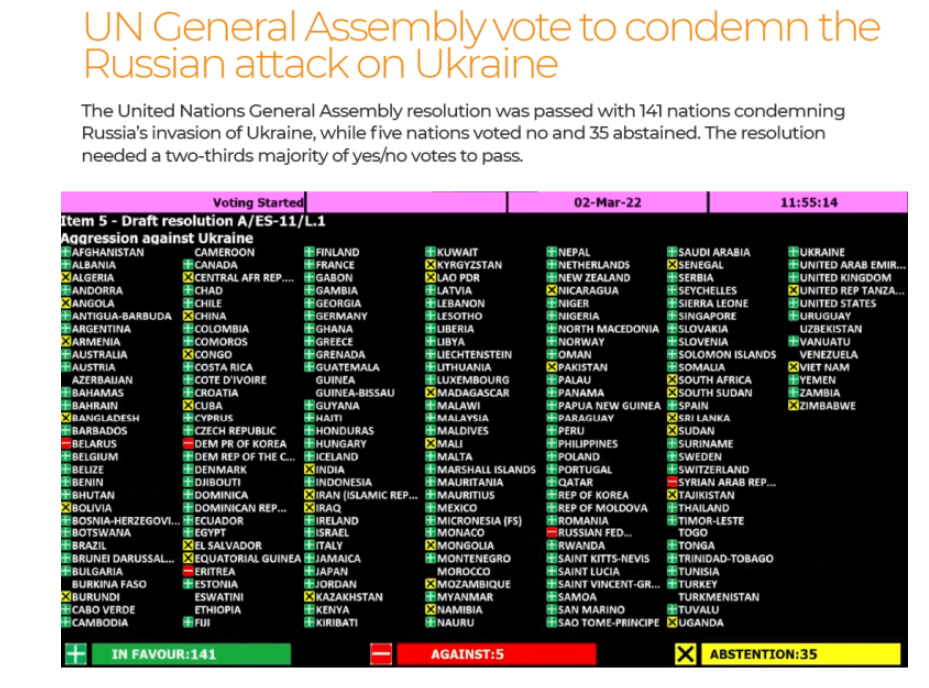
Source of Voting Record: Al Jazeera
Stand With Socialistic China – The Main Target of U.S. and Australian Imperialism
Unlike their U.S. and West European allies, the Australian imperialists have few economic interests in the former Soviet countries. So why then is the Australian regime getting involved in the sanctions against Russia and the arms flow to Ukraine? We know that this has nothing to do with defending a people’s right to sovereignty. After all, the current political order here was formed from the genocidal dispossession of Aboriginal people, a crime which the Australian regime continues to base itself upon. For Canberra, their response to the Ukraine conflict is overwhelmingly about backing their U.S. and British allies. Australian capitalists have an interest in maintaining the U.S.-led Western domination of the world. It is U.S. might that provides the shield for Australian imperialism to exploit, rob and bully the masses of this region – the peoples of PNG, East Timor, Fiji, Solomon Islands, Indonesia, the Philippines, Sri Lanka, Thailand, etc. Thus, the Australian regime supports the U.S. everywhere in the same way that a local mafia boss always defends the supremacy of the particular big-time mafia godfather that is guaranteeing his local tyranny.
At the same time, Australian regime officials have previously urged their U.S. allies in private not to be distracted with Russia. The Australian imperialists want their senior partners focused on targeting Red China. Whereas Australia’s capitalist rulers have been joining anti-Russia actions out of their need to back their U.S. godfather, when it comes to attacking China, Canberra has actually been egging on Washington to be ever more aggressive. Today, Australia’s rulers are working their hardest to give their stance on Ukraine an anti-China bent. Indeed, Morrison and his hard rightwing defence minister, Peter Dutton, seem to be spending even more time attacking China than Russia. Morrison ranted against China for not condemning Russia’s actions in Ukraine. Yet, notably, he had no criticism of his Quad partner India also abstaining on the Western-orchestrated UN resolutions attacking Russia. Meanwhile, Australian politicians and media have been trying to equate China with Russia, suggesting that Putin’s intervention might encourage China to “threaten” countries in the Asia-Pacific. Of course, in spreading this lie of a Chinese military “threat”, they avoid mentioning that not only is China the only world power not to have fought a shooting war against an overseas country in the 21st century, she has actually not participated in a single such war in 44 years. Indeed, the deadly fighting raging today in Ukraine – not to mention the horrific results of the Western interventions in Bougainville, Iraq, Somalia, Serbia, Afghanistan, Libya, Palestine and Yemen – make a mockery of the Australian regime’s attempts to produce concrete evidence of a Chinese “threat”. Three weeks ago, however, Morrison and Albanese thought that they could finally produce such a smoking gun… or rather a shining light! They ranted that China had committed a terrible act of “aggression” when, in international waters, the Chinese Navy had… pointed a light, a laser, on an Australian warplane (that it turns out had been buzzing provocatively close to a Chinese warship). Shock horror!
So why are they manufacturing this Chinese “threat”? The answer is simple. The capitalist regimes’ hostility to China is based on the fact that the People’s Republic of China (PRC) is a socialistic state. Although China allowed in a fair degree of capitalism from the 1980s onwards, the working class continues to cling onto power in the PRC and ensures that the backbone role in her economy is formed by socialist public ownership – the mode of economic organisation that favours the working class. Thus, the Western capitalist regimes oppose the PRC for the very same reason that capitalist owners of a company oppose a militant trade union active at their workplace. They know that the existence of the Chinese workers state is a threat to their interests. They fear that the mere fact of working class rule in China will, in the future, entice working class people in the capitalist countries to also want to seize state power. This is especially the case because although China’s transition towards socialism is both fraught and far from complete, it is very easy to see the benefits that socialistic rule has brought to the Chinese masses in terms of poverty alleviation, infrastructure construction, pandemic response and improvement in social status of women.
Therefore, although socialistic China is no military threat to the people of Australia, she is by her very existence as a workers state a political threat to the system of capitalist exploitation here. However, for the very same reason that the Chinese workers state politically threatens the interests of Australia’s ruling class she is a great asset for the working class masses of Australia and the world. That is why we must stand in defence of socialistic rule in China against all the threats that she faces. We must demand: Down with the U.S./Australia/Britain military build-up against the PRC and her socialistic North Korean ally! No nuclear submarines for the Australian regime! Down with the lying “human rights” propaganda attacks on China over Uyghurs, Tibet and Hong Kong!
Capitalism Leads to Catastrophic Wars
The events of the last two weeks show what a dangerous world we live in. It is not only the bloody fighting in Ukraine. It is also the fact that the most deadly forces on the planet, the U.S., British, West European and Australian ruling classes, have used this conflict to stir up militarism at home to frightening levels. Seemingly “liberal” Australian media outlets celebrate reports – possibly faked – of Ukrainian pre-school age children wanting to kill Russians and hail Australians, likely admirers of the neo-Nazi Azov Battalion, volunteering to fight on the side of Ukraine. Meanwhile, Western ruling class “NGO” think tanks and strategists casually speak of waging all out war on their main target, Red China, as they debate whether it is worth committing forces to contain Russia given that, as they blithely put it, “a missile used in Europe can’t be used in Asia”!
It is highly unlikely, however, that this current conflict will spiral directly into World War 3. One reason is that so soon after their humiliating defeat in Afghanistan, the Western imperialists will find it difficult to con their populations into accepting direct participation in a new war, especially one against a military superpower. Secondly, the U.S., British and Australian imperialists want to save their forces for use against their main target: socialistic China. Thirdly, precisely because Russia is not at this point a fully-fledged imperialist power, the compulsion of the real imperialist powers to wage war on her is of a less intense scale. In other words, given that the markets and spheres of exploitation controlled by Russian capitalists are mostly at a regional, rather than a widespread global level, the amount of added imperialist exploitation that the richer Western capitalists could open up should Russia be defeated is relatively moderate in scale. Given that Russia is the world’s number two military power, the massive military cost that the Western imperialists would bear in trying to defeat Russia exceeds the economic gain that they would achieve from crushing her. This is how logical imperialist exploiters would think. At the same time we should realise that the capitalist ruling classes do not always act logically. Each of them are cruel and dying beasts that have long outlived their useful life. As these dying beasts thrash around desperately trying to cling onto life at the expense of those around them and often in conflict with each other, they are each capable of sometimes whipping themselves up into such a frenzy and panic that they act against their own logical interests. That is why, while it is highly unlikely that the Western imperialists will inflame this conflict still further until it blows up into World War 3… it is not 100% impossible that we will head straight to the next horrifying World War!
Right now, however, the most likely route to World War 3 is an imperialist attack on China. Of course, such an agenda is not entirely logical from even a capitalist point of view. If much of humanity is destroyed in a nuclear Armageddon there are less workers for capitalists to exploit and a smaller market to sell to. However, the economic forces driving capitalist powers into conflict with socialistic China are very strong. To make up for the internal contradictions of their economies at home, capitalists in the richer countries can only stay afloat if they increase the rate at which they loot the countries of the developing world. However, through both her aid programs and her mutually beneficial relations with developing countries, Red China is impeding the ability of the rich country capitalists to carry out the imperialist exploitation of these poorer countries. Moreover, the existence of working class rule in China is preventing the Western and Japanese capitalists from turning China into a huge sweatshop for them to exploit the way that they have already transformed large swathes of the likes of Indonesia, India, Bangladesh and the Philippines. Facing deep going economic problems at home, these imperialists simply cannot afford to allow the labour force of a country with one in five of the world’s people to be kept away from their exploitation and a market of nearly 1.5 billion people to be free from their domination. Put simply, the very solvency of the richest capitalist powers demands their destruction of socialistic rule in China… by any means necessary.
The other most likely path to humanity’s destruction in a world war is a conflict between the imperialist powers themselves. To be sure, over the last few days the different competing imperial powers have come together behind Washington against the dissident capitalist power, Russia. However, this present unity could be short-lived. Berlin and France have different interests on what the future of their ties with Moscow should be than Washington does. What’s more, the European powers are suffering much greater economic pain from the breakdown in the West’s relations with Russia than the U.S. is. Therefore, when serious negotiations progress to end this conflict – whether it is in the wake of a complete or partial Russian victory or an apparent stalemate – sharp differences could emerge between a Washington insistent that Ukraine should fight to the last drop of her own people’s blood and German-led European powers more willing to reach a compromise. Such tensions at the end of this war could then pave the way several years later for a more dangerous ramping up in inter-imperialist rivalry. Then there are the Japanese imperialists waiting in the wings. Although seemingly content today to play second fiddle to their U.S. allies, the Japanese ruling class, only too aware of their long-stagnant economy, have been aggressively promoting militarism in an effort to counter the deep pacifist sentiments amongst large parts of her population.
Given the disastrous consequences to all that would follow, it would seem crazy that capitalist powers would yet again drag humanity into another world war. Yet, as the way that the U.S. rulers have provoked this current war has shown, this is where this capitalist system leads to. In particular, because there is only a finite amount of labour, raw materials and markets in the poorer countries for the capitalists of the richer countries to grab, these imperialists are inevitably drawn into fierce conflict with each other for the “right” to subjugate the different developing countries. That is why only the sweeping away of the capitalist world disorder through socialist revolution can ensure humanity’s continued survival.
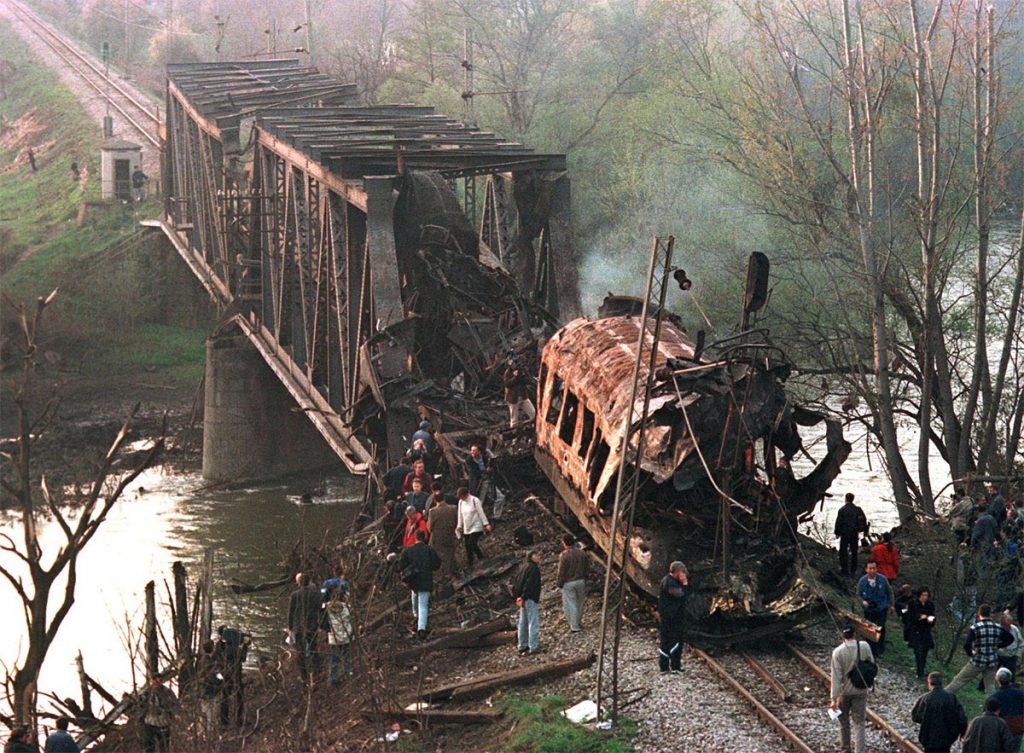
Photo Credit: Emil Vas/Reuters
Socialism and War
The attitude of us communists to war is not based on the meaningless slogan of “No War”, which every side in any war can claim to stand on providing that “peace” is achieved on their terms. Rather we understand that both lasting world peace and an end to all exploitation and oppression can only come about through the overturn of the capitalist system that breeds war. Therefore, our entire policy on war is based on advancing the struggle for socialist revolution. We do so by adhering to long established Leninist principles on what attitude should be taken to each of the different types of war. We apply these principles rigidly. There can be no exceptions. Seeking exceptions on Leninist principles on war inevitably means capitulating to the nationalism and propaganda of one or another capitalist camp in a war. Given that we are entering a dangerous period where wars and the threat of wars will be even more likely, we below outline the Leninist principles on war.
The first type of war that there can be is a class war between the forces of the capitalist exploiting class – and in some cases its rural landlord allies – on the one side and the forces of the working class and other exploited classes on the other. Such class wars can take two forms. In one form, the exploiting class is in power and wages war against the exploited classes seeking their liberation. Such a war was the 1946-49 Chinese Civil War between the Chinese capitalist-landlord exploiting class and the Communist-led poor peasants and workers. In such wars we must stand unconditionally for the victory for the exploited classes fighting for their liberation. That means we would have been full-on on the side of the Communist Party of China-led toiling classes in the Chinese Civil War. Today, despite differences in political strategy, we stand for the defence of the New Peoples Army of the Communist Party of the Philippines – standing for the rural exploited classes there – in their battles against the Philippines regime that upholds the interests of the capitalists and the agricultural landlord exploiters.
The other form of class war is a conflict between the working class already holding state power on the one side and, on the other, either internal forces of capitalist restoration or external capitalist states. In such wars, we stand unconditionally on the side of the workers state. That is why Trotskyists stood 100% for the victory of the Soviet workers state against Nazi-ruled capitalist Germany during World War II. During the 1950-53 Korean War, genuine Trotskyists stood in solidarity with the North Korean workers state and her socialistic Chinese allies against the South Korean capitalist regime and it’s U.S., Australian and other imperialist allies. Today, if a war were to break out between the Chinese workers state and the imperialist-backed Taiwanese capitalist state, the working class must stand completely on the side of socialistic China. This will be the case regardless of how the conflict begins.
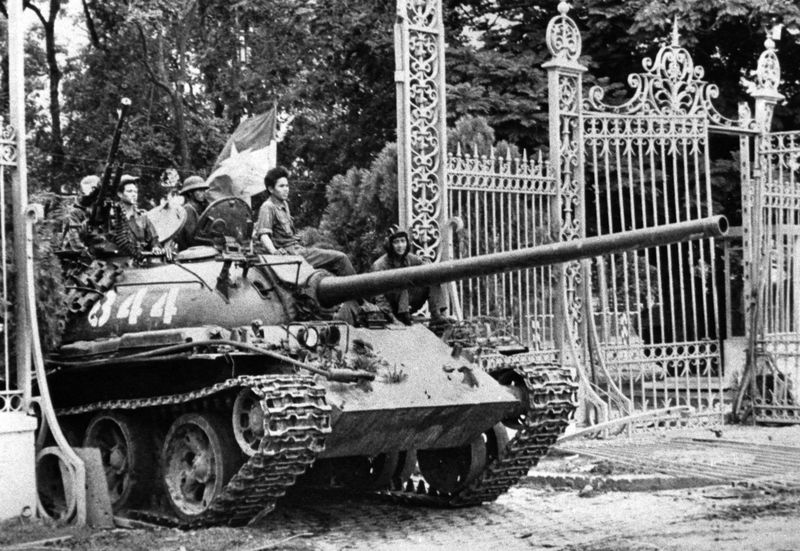
A second type of war is one between an imperialist country and a weaker capitalist country subjugated by imperialism. Lenin outlined the position that revolutionary Marxists should take in such a conflict in his crucial 1915 work Socialism and War (note that this was written before the 1917 Russian Revolution so that is when Russia was still an imperialist state):
“ … if tomorrow, Morocco were to declare war on France, India on England, Persia or China on Russia, and so forth, those would be `just,’ `defensive’ wars, irrespective of who attacked first; and every Socialist would sympathise with the victory of the oppressed, dependent, unequal states against the oppressing, slaveowning, predatory `great’ powers.”
That means we were, for example, for the defence of Iraq against U.S., British and Australian imperialism. If in future there was war between Iran and the U.S. and its allies, the Left and workers movement must stand for the victory of Iran, in Lenin’s words, “irrespective of who attacked first.”
Another related type of war is one between an oppressed people fighting for the right to self-determination and the capitalist ruling class of the oppressor nation seeking to forcibly maintain the downtrodden people in their existing state. Leninists stand with the oppressed people seeking to defend their right to self-determination in any conflict with the oppressor state. Therefore, we stand by Palestinian resistance groups in any clashes with the Israeli military. It also meant that we stood with the Russian-speaking rebels in the Donbass region fighting for self-determination.
What happens, however, if another capitalist country intervenes into a conflict between an oppressed people fighting for self determination and the state oppressing them under the guise of supporting the oppressed people? Well, if that intervening regime is an imperialist power and it intervenes into a semi-colonial or otherwise dependent country, then the character of the conflict would change. The imperialist power by its nature would only be intervening to advance its predatory agenda. The question of self-determination of the oppressed nation would be subsumed by the more fundamental issue of imperialist subjugation of poorer countries. We would in this case stand for the defence of the dependent, weaker state being intervened into – and, yes, the one that is itself oppressing the people fighting for self-determination – against the imperialist power.
But what if the capitalist state intervening into a conflict between an oppressed people fighting for self determination and the capitalist state oppressing them is a non-imperialist state? An example of this would be, say if, in the future, Syria and/or Jordan were to send its forces to help the Palestinian people of the West Bank gain independence from Israel. Of course, capitalist regimes are not interested in such liberation. The history of Arab capitalist regimes has largely been one of assisting in the subjugation of the Palestinian people. The scenario we described above could only be possible in rare circumstances. One could be when an Arab capitalist regime is highly unpopular and in danger of being toppled and, thus, seeks to recover its authority by putting itself forward as the champion of the Arab national cause. If an Arab capitalist army did send its forces into Israel promising support for the Palestinian cause, Marxists would examine the particular circumstances before determining our line. We would not ourselves promote illusions in any capitalist regime by calling for such intervention but if it actually did occur we may well accept the intervention. This scenario has relevance for the Ukraine situation today. For if Putin had sent in the Russian troops into only the areas of the Donbass controlled by the separatist rebels or at most only into areas of the Donbass where the majority of people clearly wanted independence from Ukraine, it would have been correct for Marxists to cautiously accept such an intervention. For such an intervention would have had the effect of supporting a just struggle for self determination. However, today the Russia-Ukraine conflict has extended far beyond this scenario. The all out war between Ukraine and Russia has subsumed the issue of the right to self determination of the people of Donetsk and Luhansk.
As one can see from the above, unlike the Leninist position on class war which is always unconditional support to rebelling workers and poor peasants fighting against capitalist regimes and unconditional defence of workers states, the Leninist stance on wars over the right to self-determination has always been conditional on the broader context of the conflict. Importantly, we must oppose forces intent on bringing capitalist counterrevolution to portions of current workers states disguising their agenda as one of national self-determination. For example, there was a right-wing, anti-secular terrorist movement, thankfully now largely defeated, operating in China’s Xinjiang Uyghur Autonomous Region. That movement called for the formation of an independent country for ethnic Uyghurs in that region as a means to pull that part of China into an extreme, religious fundamentalist form of capitalist rule. We Trotskyists are 100% opposed to that movement.
On the issue of separatism we once again see the blatant hypocrisy of the imperialists. They denounced Russia for its support for the forces in Donetsk and Luhansk seeking independence from Ukraine. Yet with large amounts of money, training and propaganda support, the U.S. and other imperialist regimes have supported forces in Xinjiang, Tibet and Hong Kong demanding independence from China. These movements only demanded independence from the Chinese workers state as a means to overthrow socialistic rule in their regions. That is why the imperialists supported these particular separatists. For the imperial powers, the issue of whether to support separatist movements or not is completely subordinate to their drives to protect their domination of the world and destroy workers states. In the diametric opposite way, we Leninists, while strongly supporting the right of oppressed nations to self determination, subordinate the question of self-determination to the overall struggle against capitalism and the need to defend existing workers states.
A fourth type of war is a war between rival imperialist powers in competition for spheres of exploitation. World War I was such an inter-imperialist slaughter. So was that component of World War II in which U.S., British and French imperialism eventually fought with their Germany imperialist rivals and when U.S. and Australian imperialism fought with Japanese imperialism (the biggest conflict during World War II however was a class war between the Soviet workers state and Nazi Germany and there was also a massive national liberation war fought by the leftist-led Chinese and Korean peoples against Japanese imperialism). In inter-imperialist wars, communists on all sides insist: the main enemy is at home. That means Leninists in each country mobilise the working class against the capitalist rulers and war effort of first and foremost their own imperialist country. Our end goal is to put an end to the imperialist war through socialist revolutions in each of the belligerent countries. We take an identical revolutionary-defeatist position too on a fifth type of war: that is a war between non-imperialist, capitalist states of broadly similar levels of economic strength. The squalid 1980s Iran-Iraq War is an example of this latter type of war.
Capitalism in Russia and Ukraine since the Destruction of the Soviet Union
As you can see from the above exposition of the Leninist position on wars, our stance on any war is not dependent on which side fires the first shot. We Marxists understand that wars arise when tensions between competing classes, social forces and states reach such a point that violent conflict becomes inevitable. Therefore, the particular trigger for the conflict or which side appears to be the “aggressor” is of little significance. Rather, Leninists base our position on the competing classes, social forces and states underlying the conflict. We do so from the premise that the sole path to both lasting peace and the liberation of the exploited is socialist revolution and any war policy taken must help advance towards that goal.
So what then are the competing social forces underlying the war between Ukraine and Russia and which of the type of wars that we have discussed above is today’s war in Ukraine most like? To answer this question we need to explore what type of capitalist countries are both contemporary Russia and Ukraine. Before the October 1917 socialist revolution, Russia was not only a capitalist country but an imperialist one. Yet Russia was then the most economically backward of the imperialist countries. She relied on her huge army to make it into the ranks of the imperial powers. In particular, the Tsarist regime acted as the enforcers guarding the interests of British and French capital invested via Russia into the Middle East, East Europe and the Caucasus. For playing this henchman role, the Russian capitalists were awarded with a slice of the super-profits exploited out of the masses of Russia’s neighbouring region and beyond. But the 1917 revolution put an end to this imperialism by smashing Russian capitalism. Through socialistic rule, the whole of the USSR, including both Russia and Ukraine, became an industrial and military power. However, capitalism was restored to both Russia and Ukraine in 1991-92. Nearly seventy five years of socialistic rule meant that the new capitalist Russia emerged stronger relative to the Western imperialists than she had been in Tsarist times. Therefore, the new Russian capitalist ruling class had high hopes that Russia would again become one of the world’s imperial powers. However, the restoration of capitalism led to a gigantic economic collapse throughout most of the former USSR. By 1995, Russia’s per capita GDP had plummeted more than 30% from what it had been five years earlier in Soviet times! Russia was reduced to a subordinate status to Western imperialism. Capitalist Russia’s imperial ambitions had a second problem. Spheres of exploitation within the developing world had already been divided up amongst the existing imperialist powers. There was no room for another capitalist regime to break into the game. The existing powers did their best to constrain Russia’s rise. Not one of them was willing to commit to being a reliable ally of ambitious Russian capitalism that would provide the capital required such that Russia could leverage its military power to gain a serious share of imperialist loot. The arrangement in the Tsarist times could not be simply re-created eight decades later. The Russian ruling class had a third problem. The system of socialist central planning during the Soviet days had enabled the non-Russian parts of the Soviet Union – that in pre-Soviet times had been so looted by Russian imperialism – to catch up in economy and development with that of the Russian part of the USSR. That meant that post-Soviet Russia’s capitalist ruling class could not plunder the non-Russian peoples of the former Soviet Union the way that their class ancestors in Tsarist Russia had.
As the 21st century progressed, there were important changes in the environment that Russian capitalism faced. For one, capitalist restoration hit even harder the poorer parts of the former USSR than it hit Russia. For example, per capita income in Tajikistan that in the last period of the Soviet Union was one-third that of Soviet Russia, is today just one-eighth that of Russia. This meant that Russian capital now had greater opportunities to throw around its weight in the region. Moreover, surging energy prices filled the bank accounts of Russian tycoons. Russian oligarchs splashed their capital around the world and did now make some of their income from the export of capital.
So does all this make Russia now an imperialist country or is she still a semi-dependent capitalist country that she was in the nineties? In reality, Russia is somewhere in between a dependent capitalist country and an imperialist one with some features of both. Why that matters is in what attitude one should take to a potential conflict between Russia and a fully fledged imperialist power. If Russia were to be considered an imperialist country, then Leninist principles, reflecting the interests of the class struggle, mandate that socialists must oppose both sides in any conflict between the Western imperialists and Russia regardless of the particular circumstances in which the conflict arises. On the other hand, if Russia were to be considered a country dependent on and bullied by imperialism, then the interests of the working class stand in defending Russia against the Western imperialists in any conflict regardless of the context in which the war arises. Given, however, that capitalist Russia is somewhere intermediate between a dependent country and an imperialist power, our stance in the event of a war between Russia and the fully fledged imperialist powers actually does depend on the context in which the conflict arises. For example, if a conflict between a Western imperialist power and Russia were to take place around Libya where various capitalist powers – including the U.S., France, Italy and Russia – are today engaged in multi-sided proxy wars, full of shifting alliances, aimed at grabbing for themselves control over Libya’s massive oil wealth, the international workers movement would have no side in that conflict. We would be defeatist on all sides. However, should a war between Russia and one or many of the Western imperialist powers take place within Russia, or its neighbouring region, this conflict would likely then have a very different character. For example, if the NATO powers were to directly intervene into the current Ukraine war, that would transform the character of this war. Regardless of how the conflict initially began, the war from the point of view of the Western imperialists would become one aimed at expanding the power and reach of NATO, deepening the economic subordination of Russia and sending a message to the world that anyone who dares defy Western imperialism will be mercilessly smashed. In that case, socialists must stand for the defence of Russia. However, the current conflict is not one of Western imperialism versus Russia. It is a war between Ukraine backed by the Western powers and Russia.
Could it be then argued that in this case Russia is the predatory imperialist power seeking to exploit the people of Ukraine? The answer is no! To see why, it is important to note that even before the 2014 Euromaidan coup, when the Ukrainian economy was closely integrated with Russia’s, Ukraine was not, in a sizable way, the victim of Russian imperialist exploitation. To be sure, Russian billionaires did invest in Ukraine and make big profits there. However, there was no sign of Russian capitalism arm-twisting Ukraine into undertaking economic reforms that would enable Russian capital to take over her economy. Nor was there the pressure of Russian capital forcing Ukraine to change the structure of her economy to provide goods for Russia at substandard prices. And Russia did not push Ukraine to accept gas and other goods from Russia at inflated prices. Today, Ukraine is not fighting this war to either free itself from exploitation by Russian capital or to avert the threat of such exploitation from Russia in the future.
It should be noted that although capitalist counterrevolution has caused terrible economic devastation to Ukraine, certain gains from the socialistic era take a long time to erode. Although her people’s living standards are now low by world standards, Ukraine continues to have a technically literate and highly skilled workforce and retains some of her high-tech manufacturing industries from Soviet days. What this means is that overseas capital from the likes of Russia is not able to use the necessity of providing technical expertise as a means to demand a high rate of return from investments in Ukraine. That is why no capitalist power – not even the Western imperialists – is able to exploit Ukraine with the same ferocity that they exploit their neo-colonies and semi-colonies in the so-called “Third World”. Most of Ukraine’s biggest companies and key industries remain owned by local Ukrainian capitalists – usually billionaire oligarchs – rather than overseas capitalists. Nevertheless, the Western powers have made Ukraine militarily and economically dependent on them and have been dictating to Ukraine in a high-handed, paternalistic manner. They have done so by turning on and off the tap to something that they have a lot more of than Russia, loads of capital. In classic imperialist fashion, the Western powers, via the IMF that they dominate, have been using the threat of cutting off Ukraine’s access to their capital as a means to blackmail her into instituting neoliberal economic reforms – like land privatisation. Thus, to the extent that Ukraine is under imperialist subjugation it is from the likes of Germany, the U.S., Italy and France. Yet that is not who Ukraine’s regime is fighting a war against! Rather, the Ukrainian regime is fighting a war with Russia precisely in order to maintain its relationship with Western imperialism. That is why this Ukraine-Russia war cannot be seen as an anti-imperialist war on the part of Ukraine. Rather, this Ukraine-Russia war is a squalid war between two capitalist countries whose levels of development are of roughly the same order of magnitude. Such a war is one in which the working class of each country and the world have no side.
Ukrainian and Russian Workers:
Unite to Wage Class War against Each of Your Capitalist Rulers!
The character of the Ukraine-Russia war will be clearer if we examine what each side is fighting for. The imperialist-dependent Ukrainian regime wants to join NATO. It also wants to maintain an economy integrated with the EU despite being subjected to a subordinate position within its relationship with the EU. Furthermore, the Ukrainian regime wants to forcibly and brutally cling on to all of the Donbass, despite the majority of people in a sizeable portion of that region wanting independence from Ukraine. That is hardly surprising. What drives capitalist ruling classes is maximising profits. And having control of the markets and natural resources in as large a territory as possible gives them the greatest opportunity to maximise profits.
For the very same reason, the regime serving the Russian capitalist class wants to maximise the territory under its control – whether that be through a Donbass that in the future accedes to Russia or an independent one that is very much dependent on and aligned with Russia. In pursuing this goal, the Russian regime will in the process be liberating from national/cultural-linguistic oppression those people in the Donbass who were facing brutal persecution by the Ukrainian regime. At the same time however, Moscow seeks territory extending into areas where the majority of people do not want independence from Ukraine – including into particular areas of the region where the overwhelming majority of the population are ethnic Ukrainians. In those latter areas, should the Russian operation achieve its goals, it will then be these ethnic Ukrainians who will have their right to self-determination violated. Meanwhile, another key aim of Moscow is to stop the threatening expansion of NATO onto its borders.
Lastly, the Russian capitalist class hopes to restore their level of access and penetration of the Ukrainian market to at least the level that existed before the 2014 Euromaidan coup and preferably well beyond that level. Success on this score would not be at the expense of the Ukrainian people but at the expense of Germany, other EU powers and the U.S. who have all gained a much greater share of the Ukrainian market over the last eight years. To a partial degree then, this war is the continuation of the conflicts within Ukraine since the start of this century over whether Ukraine should link her economy and security with the West or with Russia. The U.S.-led Western regimes intervened into this dispute with huge amounts of covert political funding, NGOs, propaganda, training of unarmed and armed proxies and arming of far-right paramilitaries like the Azov Brigade. Without the same financial resources as the West, lacking the level of sophistication in propaganda campaigns and without the same level of experience in the skillful use of NGOs as proxies, Russia is now responding to that earlier Western interference with military power.
That this dispute over who Ukraine will align her economy and defence with has now reached such a severity that it has contributed to an outright war shows just how desperate all of the sides have now become in the context of faltering capitalism. We oppose the efforts of Western imperialism to subordinate the peoples of Ukraine and Russia but in the greedy capitalist competition between the Western powers and Russia over who will dominate trade with Ukraine, the working class actually do not have a side – just like we do not have a side in the war that has ensued in some part because of this squabble.
Meanwhile, part of what fueled the drive to war, is that both the Ukrainian and Russian regimes have been increasingly unpopular at home and hence desperately in need of a nationalist diversion. In Ukraine there has been widespread anger with the government at persistently high unemployment, rampant corruption, falling living standards and a response to the pandemic so calamitous and so indifferent to people’s lives that well over a hundred thousand Ukrainians have died from COVID – hundreds of times more than the current civilian death toll from this current war. As a result, by January last year, the pro-Russia successor party to Yanukovych’s Party of Regions, called Opposition Platform — For Life, was actually leading opinion polls for Ukraine’s parliamentary elections. The Ukrainian regime responded with repression. In February last year, they imposed economic sanctions on a leading Opposition Platform — For Life politician and businessman, Viktor Medvedchuk, as well as other members of his party. Later Medvedchuk was placed under house arrest. Meanwhile, Zelensky consciously whipped up anti-Russian nationalism. Ukrainian troops became increasingly aggressive in the Donbass. Then, last June, Zelensky ratcheted up tensions with Moscow by imposing severe economic sanctions on Russian companies. Later, after Moscow responded with a military build-up along the Ukrainian border, the Ukrainian government – egged on by Washington – engaged in dangerous brinkmanship with Russia as a diversion from their economic and pandemic-response failures. For its part, Russia’s capitalist regime has been on the receiving end of the people’s ongoing anger over Moscow’s 2019 pension reform, a measure which greatly increased the age at which Russian people can receive pensions. Then Russia’s pandemic response ended up as disastrous as Ukraine’s. Meanwhile, especially as inflation has been soaring, there is fury at the continued massive inequality within Russia which has one of the world’s greatest levels of wealth disparity amongst large countries alongside Brazil, the U.S. and India. As a result, there has been a surge in support for far-left groups. Putin’s escalation of tensions with Ukraine and the national chauvinist upsurge that he knew would inevitably accompany it is in part aimed at refurbishing the authority of the Russian ruling class.
In summary, rival unpopular regimes whipping up rabid nationalism to ensure their own survival and prosecuting conflicting predatory claims issued by the needs of their decaying capitalist systems – mixed with the U.S. provoking Russia and pressuring the Kiev regime into a more extreme anti-Russia stance – have driven Ukraine and Russia into a disastrous war. What the working classes of Ukraine and Russia must now do is unite to oppose the war campaign of each of their respective rulers. Let’s turn this inter-capitalist war into a class war by the working class of Ukraine against the Ukrainian ruling class and by the Russian working class against Russia’s capitalist rulers! Where Russian troops and Ukrainian regular soldiers – and not the far-right paramilitary groups allied with them – are meant to be engaged in battles, there should be fraternisation between the troops in order to organise to turn the guns the other way against their own respective rulers.
For communists in each of Ukraine and Russia there are some special tasks particular to the work in each of their countries. Communists in Ukraine must make clear that they recognise the right to independence of Russian-majority areas of Donetsk and Luhansk. They must also stir up opposition to the Kiev regime’s declaration of martial law and opposition to the regime’s ban on adult males under sixty leaving the country. Meanwhile, with authorities in Ukraine handing out guns to civilians, communists should seize the opportunity to get themselves armed. Working together with trusted, non-communist class-conscious workers, they should form armed, anti-racist militias to defend minority populations like Roma, Jews, Tartars, Russians, Belarussians and Greeks that are being threatened by fascist Ukrainian paramilitary groups. Meanwhile, revolutionary socialists should take advantage of the disruption of Ukrainian state power resulting from this war. For example, where there are concentrations of politically conscious workers – and there are large numbers of pro-Soviet workers in especially Eastern Ukraine who are sympathetic to socialism and believe in social ownership of industry – and where Ukrainian state forces are especially distracted by the war with Russia, like right now in Kharkiv, Ukrainian socialists should organise workers to confiscate particular factories, warehouses and mines from their capitalist owners and transfer them into collective ownership of workers and the neighbouring community. Large mansions of the ultra-rich should be seized and used to house the homeless and those whose homes have been destroyed in the fighting. Meanwhile, when fascist paramilitaries are pre-occupied with looking out for Russian troops at their front, leftist militias should take the chance to strike blows against these fascists from the rear.
For their part, Russian communists must oppose discrimination against Roma, Ukrainians and Jews in the Donbass areas currently occupied by pro-Russian separatists or Russian forces. They must also insist that in these areas, Ukrainian has the status as one of the official languages. Those Russian leftists located within these Donbass territories should mobilise joint action with politically aware workers and other anti-racists to drive out fascists from Russia and abroad who have come to the Donbass to fight with the pro-Russian forces. Meanwhile, Russian communists must denounce Putin’s 21 February speech where he, in effect, denied the right to statehood of the Ukrainian people. Russian workers must today make clear that should the regime that rules over them win an all out military victory over Ukraine and in the, perhaps unlikely, event that it then decides to occupy or annex all of, or a large part of, Ukraine, then they the Russian toilers will then support any struggle of Ukrainian people for independence from Russia in any areas of present-day Ukraine where the majority want Ukrainian statehood – provided that such a struggle does not end up subordinate to Western imperialist interests. However, for pro-communist workers in Russia to take such a position requires political firmness. A weakness of the Russian Far Left over these last three decades, even of many of the best tendencies – that is the ones to the left of the misnamed, Russian nationalist, Communist Party of the Russian Federation (CPRF) – is that they have failed to clearly insist on the right to self determination of the non-Russian peoples of the former USSR. Instead, they have adhered to Russian patriotism. In part this is a bending to Russian nationalist moods amongst the masses. However, it also comes from not coming to terms with the fact that the Soviet Union no longer exists. In Soviet times, patriotism to the state – that is to the Soviet Union – was progressive, since the Soviet Union was a workers state. However, now Russia is capitalist. That means that patriotism to the Russian state is reactionary. Similarly, during the last period of Soviet times, separatist demands made by some Ukrainians was usually disingenuous. It was a demand made by those who wanted a separate Ukrainian country only so that they could break away from the Soviet workers state in order to restore capitalism. However, today, Ukrainian people’s wish to be in their own country independent of Russia, which is itself capitalist, has a different basis. To be sure, there remains a strong strain in Ukrainian nationalism that, following on from the capitalist counterrevolutionaries who in the last days of the Soviet Union spearheaded Ukrainian separatism, is celebratory of the Nazi-collaborating Stepan Bandera tradition and based on fierce anticommunist hatred of the socialistic USSR and its “friendship of peoples” motto. Yet there is also another strain of Ukrainian people’s wish to live in their own state that is based on legitimate fear that they will again be subjugated as second class citizens by Russians as they were in pre-Soviet Russia. This experience remains very much in her people’s collective consciousness, including through oral accounts passed on from generation to generation. The greater part of Russia’s communists have thus far failed to accept this second, very legitimate basis for Ukrainian people’s wish for national self-determination. Russian communists must rediscover the fierce opposition to Great Russian chauvinism of the Bolsheviks and especially it’s relentlessly internationalist leader, Vladimir Lenin. Here is what Lenin had to say about the Ukrainian people in Tsarist Russia:
“Accursed tsarism made the Great Russians executioners of the Ukrainian people, and fomented in them [the Ukrainian people] a hatred for those who even forbade Ukrainian children to speak and study in their native tongue.
“Russia’s revolutionary democrats, if they want to be truly revolutionary and truly democratic, must break with that past, must regain for themselves, for the workers and peasants of Russia, the brotherly trust of the Ukrainian workers and peasants. This cannot be done without full recognition of the Ukraine’s rights, including the right to free secession.”
The Ukraine, V.I. Lenin (1917), https://www.marxists.org/archive/lenin/works/1917/jun/28.htm
At the same time, in opposing their own capitalist rulers, Russian leftists must be very careful not to, even in the slightest way, align themselves with the wing of the Russian capitalist class, represented by Alexei Navalny, who are opposing this war only because they believe in cosying up to the Western imperialists. This wing of the capitalist class is typified by the greedy billionaires, Vagit Alekperov and Leonid Fedun, that own the bulk of Russian oil giant Lukoil and who have come out against the war. Russian socialists must not participate in any joint protests with Navalny supporters and other pro-imperialist opponents of the war. Any actions that they take against the war campaign of their own rulers must be clearly formulated on a pro-working class agenda. And to keep out pro-imperialists, they should ensure that the slogan of “Down with NATO” is a very prominent part of their slogans for any actions that they mobilise.
The above matters are important considerations for socialists in Russia and Ukraine. However, for partisans of the working class and oppressed in Australia our tasks are in a sense simpler and more obvious. Living in an imperialist country and under a regime that is a junior partner of the world’s sole imperialist superpower, any intervention by the Australian regime abroad will necessarily be predatory and against the interests of the toiling classes of Australia and the world. Therefore, we must oppose every single intervention that Australian imperialism makes into any crisis abroad whether that be a military, political or diplomatic intervention. We do that in a proudly “knee-jerk” – that is, principled – manner. Today that means we must oppose the aggressive interference of Australian imperialism and its Western allies in the Ukraine-Russia war and resist their efforts to use this conflict to justify increased militarism at home and further escalation of their Cold War drive against socialistic China.
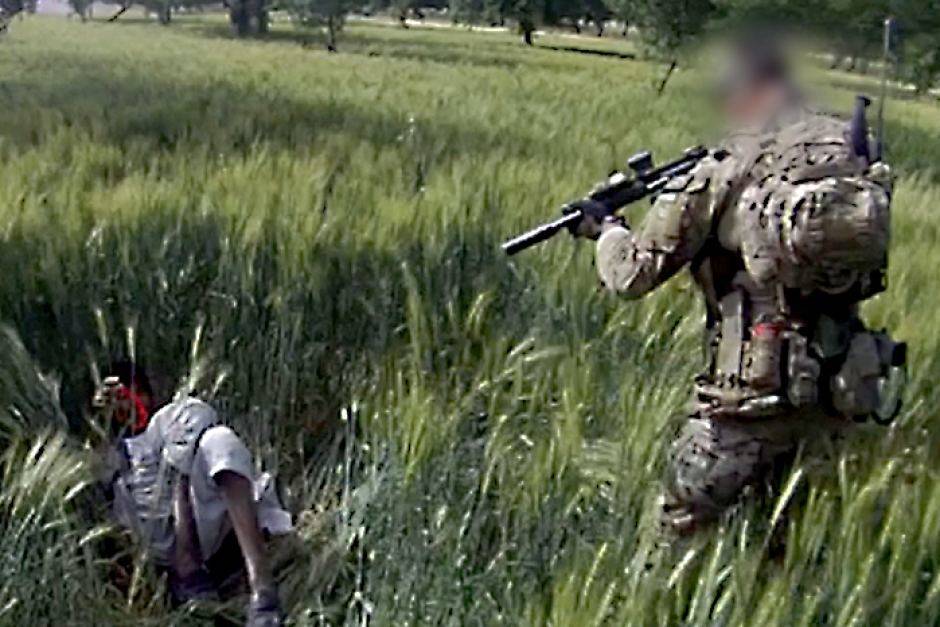
Is There a Case for Supporting Russia in This Present War?
There are a very small number of leftists in the West who believe that Russia should be outright supported in this war as distinct from our position of opposition to both Ukraine and Russia combined with staunch opposition to all forms of Western imperialist intervention into this conflict. Given that these leftists are standing diametrically opposite to the position taken by their own rulers, their arguments should be taken seriously. However, it needs to be explained why their stance is nevertheless mistaken.
One of the arguments raised by those socialists that support Russia is that the Russian intervention will, in Putin’s words, “de-Nazify Ukraine” – referring to the presence of Stepan Bandera-admiring right-wing extremists within parts of the Ukrainian state machinery and the prominent role played by fascist paramilitaries. Given that the Ukrainian fascists are extreme anti-Russian chauvinists in addition to being white supremacists, then the Russian advance is indeed likely to deal a blow to these forces. However, it is almost certain that the fascists that have flocked from Russia and some Western countries to support the pro-Russia Donbass separatists will not be suppressed. Meanwhile, promises by Putin to “de-Nazify Ukraine” ring hollow given that the Russian regime has itself allowed fascists to operate within Russia and make their way into the upper echelons of the state apparatus. Fascist ideologues like Aleksandr Dugin even became key advisers to leading Russian government officials. To be sure, most such fascists are not neo-Nazis in that they do not claim to be replicating the agenda of Hitler’s Nazis. Given that Russia was invaded by the Nazis during World War II and given that Hitler’s forces committed such horrific crimes against the peoples of the Soviet Union, any viable Russian fascist movement will not claim the tradition of the Nazis. Rather, they will like Dugin, represent a specifically Russian and Slavic form of extreme reactionary nationalism. Yet this does not make them any less destructive to the workers movement and minorities. Since capitalist counterrevolution, Russian fascists have murdered literally hundreds of immigrants, Roma, people with backgrounds from the Caucuses and Central Asia, gay people and anti-fascists. You can bet that these fascists are being emboldened by Russia’s military advances and will be swept up still further by the nationalist wave that will sweep the country should Russia win the war.
Secondly, although the Russian operation will land blows against the likes of the Azov in areas where it advances, Russian intervention into majority ethnic Ukrainian areas will surely breed sympathy for Ukrainian fascists. Capitalist forces like the Russian state cannot crush fascism because fascist forces are themselves a product of decaying capitalism – especially when that capitalism is in a particularly crisis-ridden condition. When fascists becomes a powerful movement, they consist of self-employed business owners, other sections of the middle class and a portion of the desperate unemployed population mobilised in extreme hostility to the workers movement, the Left and minorities. During a time of economic crisis, in the absence of the working class making a viable struggle to take power, the fascist forces can completely crush the workers movement and Left and institute the fascist form of capitalist rule. That is what occurred in Mussolini’s Italy and Hitler’s Germany. Ukraine has not been under this form of capitalist rule but fascists are present in sizeable numbers within the Ukrainian military, courts and police.
Now some could argue that: Did not the Allied forces de-Nazify the Western part of Germany at the end of World War II, even though they were capitalist forces? The truth is that these forces did not de-Nazify Germany. Sure, they did replace the fascist form of capitalism in the Western part of Germany with the parliamentary “democratic” form. This was because they knew that thoroughly discredited German capitalism could only survive if it made this transformation. However, unlike the Soviet-liberated East of Germany, the Allies only purged the very top echelons of the German state apparatus of Nazis. Within most of the remainder of the West German judiciary, police and military, the same officials that administered the horrors of Nazi rule were now allowed to administer “democratic” West German capitalism. Meanwhile, the Allies spirited away fascists from Central and Eastern Europe – including from the Ukraine – considered crucial to the fight against communism to sanctuary in the U.S., Australia, South America and Canada. The Allies can hardly be considered to have carried out a de-Nazification! In many ways post-war West Germany ended up like the Ukraine was at the outbreak of this war, a nominal parliamentary democracy but with a fair portion of their state apparatus infested by Nazis, albeit in Germany’s case mostly nominal “ex”-Nazis now claiming to be “democrats.” Let’s not forget that this supposedly “democratic” German state carried out fierce repression of the Left and banned the Communist Party of Germany outright in 1956. It is true that overall West Germany probably ended up with more of the trappings of a parliamentary capitalist “democracy” than today’s Ukraine, which is even more authoritarian. But that is only because massive amounts of U.S. Marshall Plan aid – aimed at heading off the strong support for communism that existed throughout Europe – allowed the Allies and the German capitalist class the opportunity to buy greater social stability within Germany. However, should Russia win this war, Moscow simply does not have the financial resources to do the same to Ukraine today even if it wanted to. A post Russian victory in Ukraine will less resemble post World War II West Germany than it will post World War I Germany, where Germany’s humiliation in World War I and the injustices – and perceived injustices – of the post World War I Versailles Treaty upon Germany generated huge resentment within the German people that fueled the rise of the Nazis.
It is only a socialist revolution or the intervention of a socialistic state that can “de-Nazify” a country. This is what the Soviet Union did to Eastern Europe and the Eastern part of Germany following World War II. However, capitalist Russia is not the Soviet Union and the army of capitalist Russia is not the heroic Soviet Red Army.
The second argument raised by leftists who support Russia in this war is that Western support for Ukraine has effectively turned this war into a war between the Western imperialists and Russia. The imperial powers certainly are giving lots of assistance to Ukraine. However, it is not at a level where one can say that the U.S., British, German and Australian regimes are effectively at war with Russia. To see more clearly why, we should compare this war with another war, the post-2011 Syrian War. In that case the U.S. and its allies intervened to a degree that it can be fully said that they were waging a proxy war against Syria. From 2012 to 2017, the U.S. directly, and through its allies in Qatar, Saudi Arabia and Turkey, gave billions of dollars of weapons to anti-government “Rebels” in Syria – including to ISIS. Britain and France joined in with their own support. Meanwhile, the CIA directly trained the “Rebels” along the Turkish-Syria border, Jordan and Qatar. This was supplemented by training operations run by Turkey and other U.S. allies. U.S. and British special forces also directly took part in operations against the Syrian Army. On 20 July 2017, the Washington Post reported that: “One [American] knowledgeable official estimates that the CIA-backed fighters may have killed or wounded 100,000 Syrian soldiers and their allies over the past four years”! Even after the West turned its focus against their former ISIS proxies in late 2014, they still targeted Syria. Several Western airstrikes in the campaign nominally directed against ISIS hit the Syrian Army and Syrian government infrastructure like oil installations. Meanwhile, although the NATO powers did strike ISIS targets, they mostly simply herded the ISIS forces away from their Kurdish and other “Rebel” allies and towards Syrian government targets. Then in 2017, the U.S. launched a massive missile strike on Syria. For their part, Washington’s Israeli allies have launched hundreds of air strikes on Syria over the years. This was fully a proxy war, in that the viability of the Syrian “Rebels” depended entirely on support from the Western powers and their allies. Given the much weaker strength of the Syrian military relative to Russia’s, the Western intervention was of a scale sufficient to mean that the prospect of the “Rebels” winning the war and over-running the Syrian capital was real. In contrast, while Western military support to Ukraine is large, relative to the awesome power of the Russian military it is nothing like the scale that would allow Ukraine to win her war with Russia and see Ukrainian forces storming in to take the centre of Moscow. The West’s aid to Ukraine is not at a level aimed at achieving total Ukrainian victory but rather at bleeding Russia over a long period. Thus, much of the weaponry that the Western imperialists have supplied to Ukraine, like hand-held missiles and rockets, is most suitable for a guerilla war against Russia. It is, of course, possible that the West could qualitatively change their level of assistance. One reason that they have not thus far is that, unlike Syria, Russia has the capacity to strike the Western powers – not just in the Ukraine but in the U.S., Britain, Australia and Germany’s own territories – should she deem that Western support to Ukraine has reached such a level that the West is directly at war with Russia. Currently therefore, we cannot say that the large amounts of Western support to Ukraine is equivalent to the U.S., NATO and Australia being directly at war with Russia.
The third – and at first glance most compelling – argument for why Russia should be outright supported in this war is the notion that a Russian victory would be a blow against imperialism. In one sense it will indeed be. Given that the Western imperialists are clearly backing Ukraine in this war, a defeat for the imperialists’ Ukraine ally may encourage others to defy the imperialists. Some of the people in Asia, Africa, the Pacific, the Middle East and South and Central America who are being so cruelly subjugated by various Western neo-colonial powers will take heart that Western imperialism has had a setback and that the side that it so clearly backed in this war has been defeated. It would also be a blow to the morale of the Western imperialists and bring a degree of self-doubt and loss of confidence to their own ranks. However, unlike the case where the imperialists are directly involved in the war, this would not have the same impact in terms of deterring future imperialist military actions. A Russian victory in this war would not have the same impact as, say, the humiliating defeat that the U.S., NATO and Australian regimes suffered in Afghanistan. That is why it really does matter that the Western imperialists are not, at this stage, directly participating in this war. Moreover, in the event of a Russian military victory, given that it will mean that their ally has been defeated by an invading force of a major military power, the imperialists will seize on it to whip up a national security obsession and a massive arms build up. This especially matters because this reactionary consequence of a Russian victory will not be countered by any inspirational effect of that victory upon active workers and leftists within the imperialist centres. This will be then be very different to the impact of the Vietnam War when communist-led Vietnamese revolutionaries defeated U.S. and Australian imperialism. That struggle greatly energised working class and leftist struggles worldwide and prevented the rulers of the defeated imperialist countries from using the defeat to stir up increased militarism.
To get a strong sense of how a Russian victory would affect the political climate, we merely need to observe the political winds over the last two weeks. Far from the working class masses and leftists being energised by the Russian advance, it is the imperialist regimes that have been filled with renewed confidence, including here in Australia. They have used the Russian intervention to divert attention from falling living standards at home, incite militarism, cynically paint themselves on the world stage as the defenders of weaker countries and “justify” ramping up still further their campaign against their main target: Russia’s friendly partner, the PRC. The German ruling class have used the war to justify radically increasing the country’s defence budget. Washington has, meanwhile, been skillfully getting the leaders of Eastern European regimes to “request” increased American troop deployments in their own countries. All this is, after all, why Washington provoked the Russian invasion in the first place. If Russia ends up winning the war, all these political winds will blow still stronger.
Overall, should Russia win the war, there will be some negative consequences and some positive ones for workers movements and leftist forces around the world. What is clear is that there will be no clear-cut raising of the consciousness of the working class should Russia win the war. And it is the working class of the world – and not emerging capitalist powers – that is the force that alone can smash imperialism.
Although the effect of a potential Russian victory on the position of the working class in the imperialist centres is somewhat ambiguous, the impact of such an outcome on Russia is very clear cut. It will strengthen the capitalist regime, electrify Great Russian chauvinism and embolden far-right forces. Ominously, during Putin’s crucial 21 February speech, he threw his support behind the Ukrainian regime’s “decommunisation” policy involving the persecution of communists and the banning of communist parties. Should capitalist Russia’s forces win the war, expect Putin to go after the Left, especially targeting those tendencies that are more internationalist and closer to being authentically communist than the patriotic CPRF.
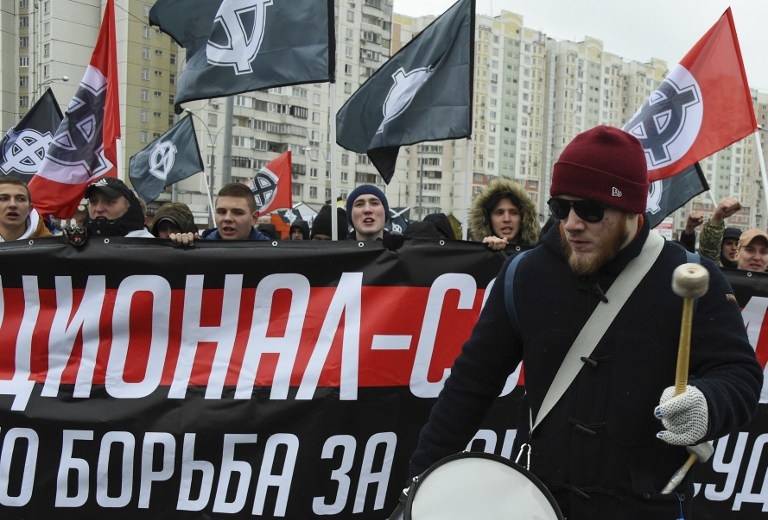
Photo Credit: AFP/Pool/Vasily Maximov
This War is the Result of Capitalist Counterrevolution in the Former Soviet Union
Our insistence that it is capitalism that breeds war is proven by one very obvious fact: this Ukraine-Russia war would not be occurring if it was the working class that ruled Russia and Ukraine – as in the days of the former Soviet Union. The Soviet workers state was created by the 1917 socialist revolution led by the Bolsheviks. Key to the Bolsheviks success was their intransigent defence of the rights of all the minority nationalities oppressed under the Tsarist Empire. It was only in this way that they were able to unite the workers and poor peasants of the whole country. The Bolsheviks’ Central Committee that led the party’s work during the Revolution was itself disproportionately made up from the country’s minorities, including Ukrainians. Even after the Revolution, Lenin and Trotsky’s Bolsheviks took great pains to insist on the national rights of peoples who had been downtrodden in Tsarist times by the “Great Russians” (as ethnic Russians were then formally referred to): This was typified in a 1919 letter that Lenin wrote when the young workers state was in the midst of a Civil War against the overthrown capitalists trying to recapture power under the leadership of former Tsarist generals like Anton Denikin:
“… The independence of the Ukraine has been recognised both by the All-Russia Central Executive Committee of the R.S.F.S.R. (Russian Socialist Federative Soviet Republic) and by the Russian Communist Party (Bolsheviks). It is therefore self-evident and generally recognised that only the Ukrainian workers and peasants themselves can and will decide at their All-Ukraine Congress of Soviets whether the Ukraine shall amalgamate with Russia, or whether she shall remain a separate and independent republic, and, in the latter case, what federal ties shall be established between that republic and Russia.
“How should this question be decided insofar as concerns the interests of the working people and the promotion of their fight for the complete emancipation of labour from the yoke of capital?
“In the first place, the interests of labour demand the fullest confidence and the closest alliance among the working people of different countries and nations. The supporters of the landowners and capitalists, of the bourgeoisie, strive to disunite the workers, to intensify national discord and enmity, in order to weaken the workers and strengthen the power of capital….
“Secondly, the working people must not forget that capitalism has divided nations into a small number of oppressor, Great-Power (imperialist), sovereign and privileged nations and an overwhelming majority of oppressed, dependent and semi-dependent, non-sovereign nations. The arch-criminal and arch-reactionary war of 1914-18 still further accentuated this division and as a result aggravated rancour and hatred. For centuries the indignation and distrust of the non-sovereign and dependent nations towards the dominant and oppressor nations have been accumulating, of nations such as the Ukrainian towards nations such as the Great-Russian….
“Experience has shown that this distrust wears off and disappears only very slowly, and that the more caution and patience displayed by the Great Russians, who have for so long been an oppressor nation, the more certainly this distrust will pass….
“If a Great-Russian Communist insists upon the amalgamation of the Ukraine with Russia, Ukrainians might easily suspect him of advocating this policy not from the motive of uniting the proletarians in the fight against capital, but because of the prejudices of the old Great-Russian nationalism, of imperialism. Such mistrust is natural, and to a certain degree inevitable and legitimate, because the Great Russians, under the yoke of the landowners and capitalists, had for centuries imbibed the shameful and disgusting prejudices of Great-Russian chauvinism….
“Consequently, we Great-Russian Communists must repress with the utmost severity the slightest manifestation in our midst of Great-Russian nationalism, for such manifestations, which are a betrayal of communism in general, cause the gravest harm by dividing us from our Ukrainian comrades and thus playing into the hands of Denikin and his regime….“
V.I.Lenin, Letter to the Workers and Peasants of the Ukraine, 28 December 1919, Lenin’s Collected Works, 4th English Edition, Progress Publishers, Moscow, 1965, Volume 30, pages 291-297
Since it was based on socialist, collective ownership of the means of production, the Soviet economic system naturally brought people together, including people of different ethnicities. Meanwhile, Ukrainian literature and culture like that of many other minority peoples was promoted and flourished during the first fifteen years of the Soviet workers state in a way that was completely unheard of in the capitalist times. The use of Ukrainian language and its teaching in school was massively expanded within the Ukrainian Soviet Socialist Republic of the Soviet federation. However, the young Soviet workers state also faced immense challenges. The defeats of the revolutions that she inspired abroad left the workers state isolated and besieged by imperialism. Under these pressures, the Soviet workers state was pushed a big step backwards in the mid-1920s. The Soviet Union remained a workers state based on socialist property forms embodying terrific gains for the masses. But a more conservative, right-ward moving faction, representing the bureaucracy that emerged atop the workers state, took over the party and suppressed the workers democracy that had enlivened the first few years of the workers state. The new Soviet leadership slid backwards in many areas including on its attitude to minority peoples. Concessions were made to Great Russian chauvinism. Certain former Tsars and Tsarist military leaders were now portrayed favourably. In 1933, there was a partial roll back in the policy of enthusiastically developing Ukraine’s own distinct culture. For a period, from the mid-1930s to the mid-1940s, some nationalities were treated harshly by Stalin’s government in a way that echoed the Tsarist times. However, overall, the minority nationalities’ position improved greatly. The peoples who were poorest and most subjugated in Tsarist times, including the peoples of Soviet Central Asia, gained the most from the Russian Revolution.
Following the continued rapid advancement of the Soviet economy after World War II, the material basis for the repressive administration of the bureaucracy – that is scarcity – weakened. Consequently, in the mid-1950s, the Soviet Union’s bureaucratic rulers had to relax rigid controls. Along with this they righted most of the wrongs done to certain nationalities during the second half of Stalin’s reign. They also reversed the notion of Great Russians as the natural leader of the Soviet peoples pushed in that period. The culture of the minority nationalities of the socialistic USSR again flourished with renewed vigour along with the economic standard of living of their peoples. For the following three decades, the different ethnicities of the socialistic USSR lived in greater harmony and with more genuine friendship amongst her different peoples than in any other heavily multi-ethnic country in the world. To be sure, since the Soviet Union’s transition to full socialism could not be completed while the pressure of the richest countries in the world remaining capitalist continued to exist, racial and ethnic prejudices could not be completely eliminated. There remained a degree of Russian centredness within the Soviet Union. However, in no way can it be said that the minority nations of the USSR were exploited by the ethnic Russian nation as in pre-Soviet times. So much so that in 1990, just before the destruction of the Soviet Union, per capita income was not only higher in the Baltic republics of the USSR than in Soviet Russia but also higher than in Soviet Russia in the Kazakh Soviet Socialist Republic of the Soviet Union – a region that had been extremely poor in Tsarist times. Meanwhile, in the Ukrainian Soviet Socialist Republic, per capita income was roughly the same as that in Soviet Russia (just 5% lower), while average life expectancy was nearly a year and a half higher than in Soviet Russia.
However, the closer that the Soviet Union came to catching up in economy with the richer of the capitalist countries, the more that the lack of workers democracy impeded the development of her planned economy. As a result and with her economy strained by trying to keep up with a massive U.S. military build up, the Soviet economy started to stagnate by the early 1980s. This stagnation and the combined effect of intense imperialist military, economic and political pressure led to the ascendancy of more rightist elements to the Soviet leadership in the mid-1980s. This new Soviet leadership, headed by Mikhail Gorbachev, embarked on market reforms to try and spur the economy. But these reforms increased income inequality. This encouraged pro-capitalist tendencies within sections of the most educated youth who believed that they would gain from capitalist restoration. This layer pushed for yet more right-wing economic reforms which increased inequality still further and that in turn further nourished the rise of pro-capitalist forces. The USSR was spiraling towards capitalist counterrevolution.
The emerging pro-capitalist forces espoused nationalism as a way to get broader layers of the population behind them. In the Ukraine, these counterrevolutionaries formed a Ukrainian Popular Front, called the Rukh, to call for Ukraine’s separation from the Soviet workers state as a means to achieve capitalist restoration. The Rukh is the spiritual father – and sometimes the actual source – of today’s pro-Western, Ukrainian nationalists. During the last days of the USSR, although the Rukh were able to point to a degree of Russian centredness within the Soviet system to gain support, their far more persuasive pitch was to point to growing Great Russian nationalism within Russia. One manifestation of this was the emergence of the extreme Great Russian chauvinist group, Pamyat. The rise of such Russian fascists naturally engendered fears amongst Ukrainians and other minority nationalities that they could again be subjugated by the Russians as in Tsarist times. The primary factor driving increased reactionary nationalism in the final period of the USSR was the increased inequality and competition between the different regions of the USSR spurred by Gorbachev’s market reforms, which allowed each republic to keep more of the wealth generated in its own area rather than be re-directed for the benefit of the whole USSR. This growing ethnic nationalism sparked by market reforms and by the increasing weight of pro-capitalist forces was a driving force for capitalist counterrevolution throughout the USSR. Nevertheless in March 1991 when a referendum was held on preservation or not of the Union of Soviet Socialist Republics, more than 71% of Ukrainians voted for maintaining the USSR, in an election with a voter turnout of 83% in the Ukraine.
Although a very small number of people became very rich out of the 1991-92 capitalist counterrevolution, it was a disaster for the overwhelming majority of people of the former USSR. This was true too for the people of Ukraine. Capitalist restoration led to economic collapse. To see how much this is the case we will compare the Ukraine with a country that remained under socialistic rule: China. In 1989, the year before Ukraine and the rest of the USSR started sliding rapidly towards capitalist counterrevolution, her average life expectancy was 70.5 years, one and a half years higher than in Red China. However by 2019, her life expectancy was five years lower than in China. Even more striking is a comparison of per capita income. In 1990, the average per capita income in the Ukrainian Soviet Socialist Republic was nearly eight times higher than in the PRC. However, by 2020, capitalist Ukraine’s per capita income was 25% lower than in socialistic China.
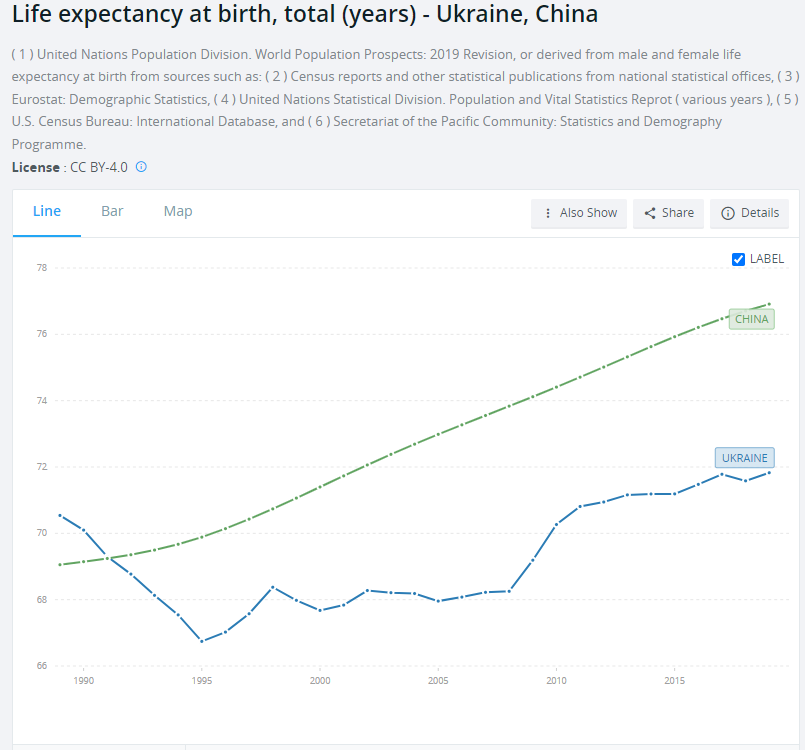
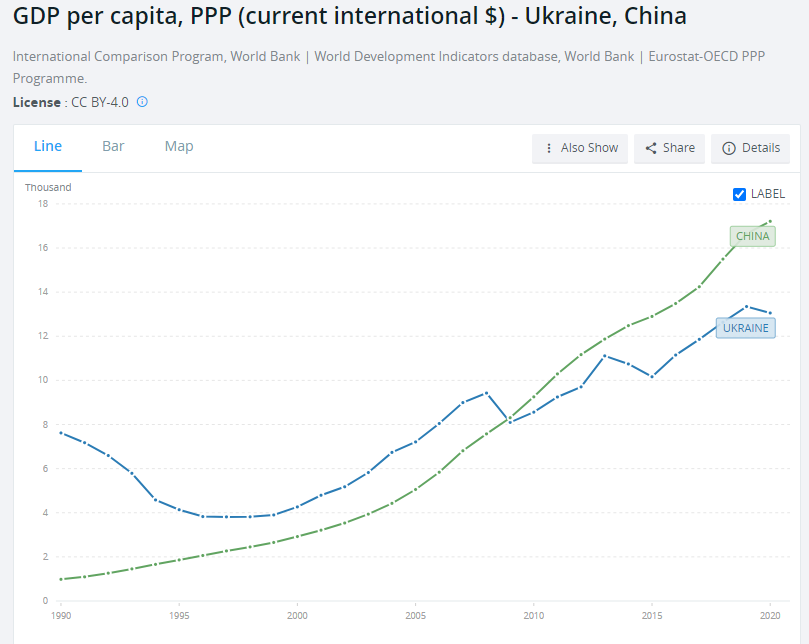
In order to divert the masses from the truth that they were now being exploited by a section of their own people, the new capitalist regimes that rose to power through destroying the socialistic USSR blamed other nations and ethnic groups for the devastation of living standards in their own countries and regions. In this way, they tore apart peoples who had for decades lived together in peace and friendship and re-ignited long dormant, ancient prejudices and grievances. Just like in the former Yugoslavia, which underwent capitalist counterrevolution around the same time, the drive to capitalist restoration and its aftermath sparked bloody ethnic and national conflicts in the former USSR. In wars in Armenia-Azerbaijan, Chechnya, the Transnistria region of Moldova and the South Ossetian and Abkhazia regions of Georgia, between 160,000 to 200,000 former Soviet residents were killed. In subsequent phases of most of these wars and in the 2008 Russia-Georgia War, a further 65,000 to 80,000 people were killed in total.
As all this conflict raged in their neighbouring region, the new capitalist leaders of the two biggest countries that emerged out of the Soviet Union, Russia and Ukraine, gradually pulled their people apart as they both pushed nationalism as a means to hold their societies together in the face of the hardships caused by capitalist restoration. And the more corrupt their rule and the more furious the masses grew at the fact that they were undergoing economic hardships while a few had become obscenely rich, the more that the capitalist rulers of Ukraine and Russia promoted aggressive national chauvinism and hostility to each others’ counntries. The aggressive nationalism of the official leaders in turned spawned the rise of far-right groups in both countries who in turn pushed for a still more confrontationist stand against each country’s rival nation. Throw in plenty of aggressive meddling, manipulation and provocation by Washington and now we have this disastrous war. “This is like what happened in the former Yugoslavia played out in slow motion”, stated with great sadness Yuri Gromov, editor of Trotskyist Platform, who was born in the Kazakh Soviet Socialist Republic of the USSR and like so many people from the former USSR is of mixed ethnic heritage – part Roma, part Jewish and part Ukrainian and Russian.
Given that the current war and the other deadly wars in the former USSR over the last three or so decades are the direct product of capitalist counterrevolution and the drive towards it, it is obvious what the solution is: the restoration of working class rule! Should the working class again come to power in some or all of the former Soviet countries, whether or not some or all of the new workers states choose to join together in a new version of the Soviet Union is a question for the masses of each country. However, that really is a secondary question. The main point is the need for new Great October Socialist Revolutions in the lands of the former USSR. However, to ensure that these new workers states do not again degenerate and crumble under hostile imperialist pressure, we must fight for socialist revolutions in the imperialist centres – that is in the likes of the U.S., Britain, Australia and Japan.
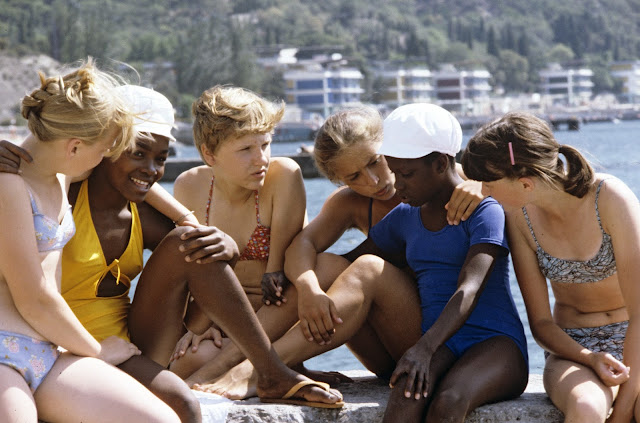
Photo Credit (above photo): Vintage Everyday
Photo Credit (below photo): Sergei Supinsky/AFP
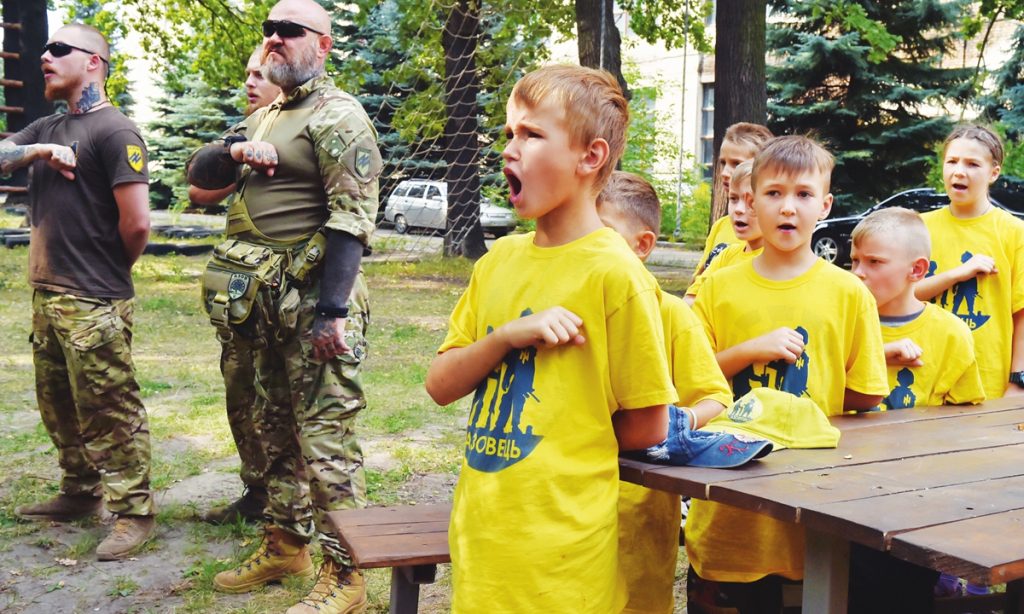
The Myth of a Clash Between “Democracy” and “Authoritarianism”
The biggest lie told by imperialist regimes about this current war is that this war is part of a broader “conflict between democracy and authoritarianism.” However, the Western “democratic” powers really have little commitment to “democracy” in even the very limited sense that they mean by the word. Washington and its allies back one of the most brutally authoritarian regimes in the world, Saudi Arabia, in its murderous war against the people of Yemen. What makes the way that they have framed the current conflict especially dishonest is that while the capitalist Putin regime is indeed “authoritarian”, the Kiev one that they are backing is even more so. Not only has the Ukrainian regime been murderously persecuting those seeking independence in the Donbass, it has jailed large numbers of pro-Russian and leftist opposition activists throughout the country. Opposition politicians, especially those expressing pro-Russia views, have been hit with bogus charges and arrested. As part of this repressive policy, the regime has not only enacted laws mandating the firing of all civil servants who were senior officials during the Soviet days but also all those who were employed during Yanukovych’s presidency. This is equivalent to the current Liberal government in Australia sacking all senior public servants who were in office during the previous Labor administration. By one year after the implementation of this purge, the Ukrainian capitalist state purged 700 senior public servants. Many more resigned themselves. Meanwhile, through its “decommunisation” policy, the Kiev regime has prevented the Communist Party of Ukraine – which in the elections immediately preceding Euromaidan received more than 13% of the vote – from standing in elections. The measures also mean that anyone who displays a communist or Soviet flag, sings the communist Internationale song or the Soviet anthem can be jailed for five years. Similarly, those who question the “heroism” of the Nazi-collaborating Ukrainian paramilitary groups – including the Ukrainian division that was formally incorporated into the Nazis Waffen-SS – are jailed! Meanwhile, books with even the slightest criticism of these Holocaust-participating groups have been banned in Ukraine.
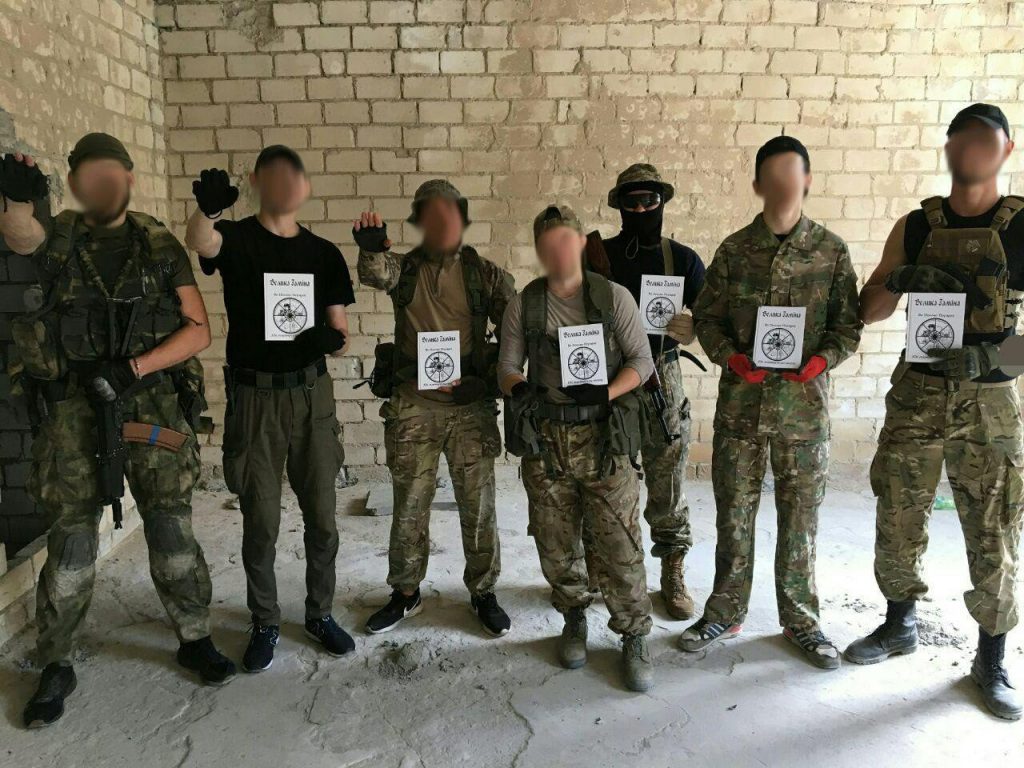
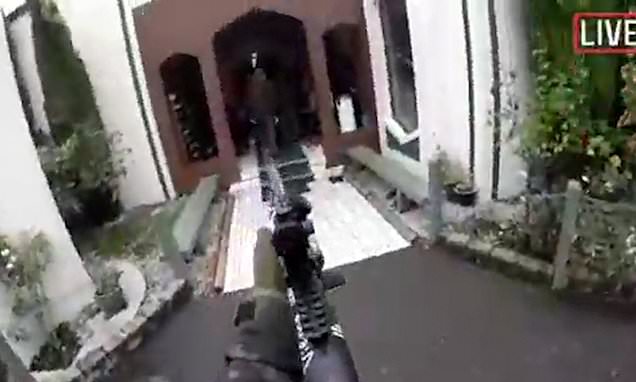
While the Kiev regime has outlawed the unfurling of Soviet and communist symbols and the singing of communist songs and has banned books that contradict their warped version of history, they have allowed neo-Nazi organising, agitation and literature to flourish.
Photo Credit (bottom photo): Stuff
The Ukrainian capitalist state’s embrace of fascist elements extends well beyond ideology and symbols. In late 2014, the Ukrainian National Guard incorporated into its ranks the neo-Nazi Azov Battalion (a militia so extreme in its white supremacy that the Australian fascist who murdered 51 Muslims in New Zealand in March 2019 wore on his flak jacket the symbol most closely associated with this militia whom he also hailed in his manifesto). This is the same as if the U.S. were to incorporate the Ku Klux Klan into its National Guard! With such official sanction and with individual fascists in leading positions within the state machinery, Ukrainian neo-Nazi paramilitary groups have felt emboldened to murder several members of the Roma community, burn synagogues and attack the LGBTIQ community. In 2018, they conducted simultaneous violent attacks on International Women’s Day rallies in several Ukrainian cities. These far-right terrorists are rarely ever prosecuted for such crimes – they seem to have impunity. So too do those who murder dissident journalists and social activists in Ukraine. In April 2015, pro-Russia journalist, Oles Buzina, was shot dead. The following year, investigative journalist, Pavel Sheremet, was killed in a car bomb. Then in July 2018, anti-corruption campaigner and local council member, Kateryna Handzyuk, was murdered in a terrifying acid attack.
Among the most extreme cases of the Ukrainian regime abetting far-right terror was seen in the multi-ethnic city of Odessa on 2 May 2014. There Ukrainian fascists attacked a protest by anti-government and pro-Russian activists. When the activists took sanctuary in the city’s Trade Union Hall, the fascists set the building alight and beat those who managed to escape the flames. The Ukrainian police simply stood aside and watched the activists get murdered and allowed the fascists to block firefighters from using their equipment. In all, Ukrainian fascists, abetted by the police, murdered 45 anti-Euromaidan activists that day.
Meanwhile, the Ukrainian capitalist regime is so racist that Ukrainian border guards have prevented international students (from places like Nigeria, Zimbabwe, India and Morocco) fleeing the recent war from boarding trains to exit Ukraine. The guards have given preference to Ukrainians, racially abused dark-skinned students and forced international students approaching the border to alight from vehicles and walk huge distances in freezing weather to get to the border so that Ukrainians could use their vehicles instead. Moroccan student Amani al-Attar told Al Jazeera news the experience that she and her friends had trying to cross the border into Poland from Ukraine. She says that she saw Ukrainian troops beat some international students with batons or the butts of rifles. “The army differentiated between people depending on their skin colour and gender,” said al-Attar. The Al Jazeera report continued:
“Also, the darker your skin the worse and longer the wait,” al-Attar told Al Jazeera, adding Black people and Asians were beaten and sent to the back of the queues.
“At this point, people were splayed on the ground with hypothermia. Others were collapsing from exhaustion. But that was just us Arabs, Black people and Asians. Ukrainians got through in minutes,” she said.
So much for the basic democratic principle that everyone is equal before the law that the Western powers are supposedly fighting to defend by backing Ukraine in this war!
As for the so-called “democracy” that the Western capitalist powers claim to practice, this is not a democracy for all the people but in practice only a democracy for the rich. For although everyone can vote in their “democracies”, the whole political atmosphere is shaped by heavily funded political parties, electoral advertising, lobbying and privately funded think tanks, all of which the ultra-rich have a greatly disproportionate ability to finance. Therefore it is they the rich capitalists who entirely dominate political life. Meanwhile, it is they, or the government that serves them, that own all the major media, thus ensuring that the capitalists’ “democratic” grip over public opinion is super tight. Meanwhile, which ever party wins elections, they administer a state whose judges, police, military officers and other top personnel are tied by thousands of threads to the powerful big end of town. Therefore, what we have in capitalist “democracies” is a tyranny of the tycoons. In Australia, the right to strike is so severely restricted that it would make any “authoritarian regime” proud. Meanwhile, the Australian regime has hit David McBride, one of the people who exposed the military’s horrific war crimes in Afghanistan, with charges that could see him imprisoned for 50 years for his whistleblowing. As for the “leader of the democratic world”, the U.S. regime, it is the world’s biggest jailer. The number of people that the U.S. jails is equal to 80% of the entire population of the Ukrainian capital, Kiev! Moreover, it is not only in interventions abroad that the Western “democratic” regimes commit heinous crimes. Racist U.S. police shoot dead on average more than one thousand people every year – disproportionately black and other people of colour. Here, the regime not only murders Aboriginal people in state custody but removes Aboriginal children from their families with all the intensity of the Stolen Generations period but with more “democratic” cover.

It is true that there is right now a bit more space for anti-government protests in some Western “democracies” than there is in Russia – and certainly much more than in the Ukraine. Yet, this is only because right now their rule is more stable than in either Russia or Ukraine due to these rich country capitalists being able to pacify a sizable chunk of their middle class and a better paid section of their working class by giving them a small share of the massive profits that these imperialists reap from exploiting the peoples of the “Third World”. However, whenever they are afraid of significant opposition, these Western “democrats” throw out their own supposed “democratic principles” in a flash. Thus, afraid that opposition to their dangerous interference in the Ukraine-Russia war will emerge, the Western powers are violating all their claims to stand for “free speech” by censoring pro-Russia voices. The European Union banned Russian media outlets RT and Sputnik from broadcasting in the bloc. In Australia, an audience member in the ABC’s Q + A current affairs program who asked a question that called out media bias in reporting the conflict, was summarily expelled from the program by its presenter! Meanwhile, the Australian government is pushing Facebook, Twitter, Google, TikTok, Reddit and other digital platforms to block content generated by Russian media. This will mean that individuals who express views agreeing with those made by Russian media on some issues will inevitably also be censored
Worried about the growing strength of socialistic China, the “democratic” Western rulers are actually becoming increasingly authoritarian. Here, they have not only witch-hunted members of the Chinese community and other public figures that have dared to show sympathy towards China but have also unleashed threatening police raids against such individuals – as they did to a NSW Labour MP who in 2020 dared to praise China’s successful response to the pandemic. When they see a powerful challenge emerging to their rule, as it inevitably will, these “democrats” will not hesitate to use the most brutal authoritarian methods to try and crush opposition forces. Let us remember that the big time German capitalists who ended up supporting Hitler were one time “liberal democrats”! What the Western capitalist ruling classes, like all capitalists, really care about are not any abstract principles of “democracy” but preserving their rule of exploitation and expanding their super-profits. These are the reasons why they participate in wars and provoke wars fought by others. Capitalist rulers – whether from imperialist countries or dependent ones – have never fought or supported an external war for the sake of “democracy” … and they never will!
The main reason that the imperial powers want to frame the current war as a “contest between democracy and authoritarianism” is that they want to utilise public anger at Russia over this war to motivate their Cold War against socialistic China. To do this they seek to put China in the same boat as Russia. On Monday, Morrison blustered that Australia and the world were being challenged by an “arc of autocracy” involving Russia and China. Yet the truth is that China has maintained a strictly neutral position on this war. Although she has not condemned Russia’s intervention, she has not endorsed it either. China maintains friendly relations with Russia not out of any shared belief in “autocracy” or “authoritarianism,” as the imperialist regimes would have us believe, but firstly, because both are being targeted (albeit for very different reasons), by Western imperialism and secondly, in order to pursue mutually beneficial trade relations and technology exchanges.
Media propaganda has been so desperate to link Russia and China together that they have even, quiet ridiculously, portrayed Putin as some sort of unconscious, semi-communist. They keep on referring to Putin saying 17 years ago that, “the collapse of the Soviet Union was a major geopolitical disaster of the century.” But Putin was not here referring to the collapse of socialistic rule in the Soviet Union. After all he personally played an active part in the capitalist counterrevolution that destroyed the Soviet workers state. During the counterrevolution, Putin was an adviser to then Leningrad/St Petersburg mayor Anatoly Sobchak, who was the second most prominent force in Russia promoting the capitalist counterrevolution next to Boris Yeltsin. What Putin was lamenting was only the breakup of a unitary state encompassing the region of much of the pre-Soviet Tsarist empire. This is clear if one reads what he said immediately after that often quoted phrase:
“As for the Russian nation, it became a genuine drama. Tens of millions of our co-citizens and co-patriots found themselves outside Russian territory. Moreover, the epidemic of disintegration infected Russia itself.”
It is clear that what Putin was lamenting was that Russians were no longer in a unitary state and had lost power. Putin had hoped that the socialistic Soviet Union would be replaced by a capitalist Russian-dominated empire on the territory of the old Soviet Union. Putin’s goal is definitely not a new Soviet workers state but a new Russian empire like the Tsarist one. To get a sense of Putin’s ideology, one has only to read his 21 February address to the Russian nation, the speech where he announced the recognition of the independence of Donetsk and Luhansk. The entire first one-third of the speech was a tirade against communism, the Soviet Union, the Bolsheviks and especially its leader Lenin. Putin particularly takes aim at the Bolshevik policy of upholding the right to self determination of the non-Russian peoples of the Soviet Union. All this should not be one bit surprising. This ideology is entirely consistent with the practice of a long-time administrator of Russian capitalism who seeks a new Russian sphere of influence within the territory of the former Soviet Union.
In actual fact there is a political Great Wall that separates China from Putin’s Russia. China is a socialistic state. Russia in contrast is a capitalist country, just like the U.S, Australia, Ukraine, India, Indonesia and the Philippines. The Western ruling classes are antagonistic towards Russia only because their predatory capitalist interests happen to clash with the interests of the Russian capitalist class. It has nothing to do with “democracy versus authoritarianism” or “democracy versus autocracy”. The hostility of the Australian and American capitalist rulers towards China also has nothing to do with “democracy versus autocracy.” However, it is for a very different reason to their opposition to Russia. Their enmity towards the PRC is all about the enmity of capitalist rulers towards socialistic states.
It is true that the Chinese workers state does not presently operate in the ideal form of a workers state, which is workers democracy – where political power is exercised by elected councils of workers and their allies in which all those who uphold working class rule will be able to freely debate and decide on matters. Instead, the working class hold power in China in an indirect manner with political administration monopolised by a middle class bureaucracy that administers the socialistic economy, while bending to the pressures of both world imperialism and China’s small capitalist class. That true workers democracy is not dominant in China weakens the workers state and makes it less resistant to attack from capitalist counterrevolutionaries claiming to stand for “democracy”. Therefore, we stand for workers democracy to be achieved in China in the course of the working class mobilising in action to confiscate China’s tech, real estate and retail sectors from the hands of the capitalists and placing it into the hands of the workers state. We want the Chinese workers state to be strengthened and for her progress towards socialism to be accelerated. However, the current lack of genuine workers democracy in China is hardly why Scot Morrison and Co. are hostile to the PRC! After all they have no wish to strengthen the Chinese workers state!
The Australian ruling class’ talk of opposing “authoritarianism” and “autocracy” when “explaining” their opposition to China and their lumping in of China with capitalist Russia are part of a conscious attempt by them to deceive the masses about the real reason for their hostility to China. That real reason is simply the enmity of the capitalist class to states ruled by the working class. Australia’s capitalist rulers know all too well that if the working class here understands the true reason for the ruling class’ hostility to the PRC, large parts of the working class would choose to side with workers China.
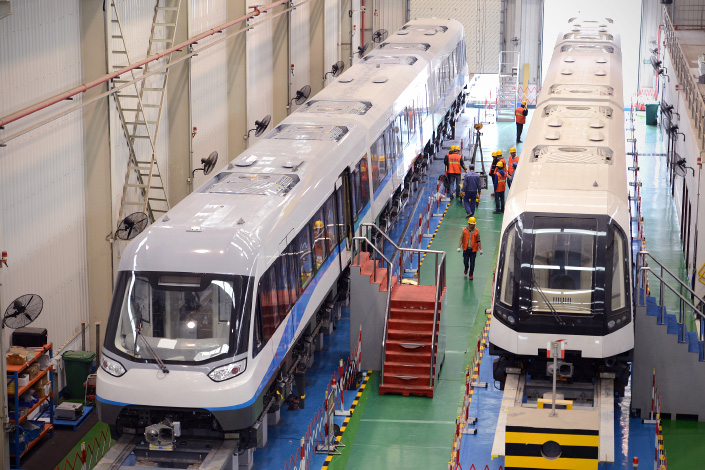
Let Us Learn from the Bolsheviks
In the face of the intense propaganda campaign being waged by the imperialist powers and their media about this war, it is necessary for socialists to stand firm and advocate the line that expresses the interests of the workers and all the oppressed. Unfortunately, much of the Left have not stood firm. They have capitulated to the propaganda of the ruling class and more precisely to the middle class “public opinion” that this propaganda has created. Thus, the article on the conflict in the website of the Socialist Alternative (SAlt) group calls for solidarity and support to “the Ukrainians who are bravely fighting against Russian invasion.” Although SAlt criticises the West for not showing similar support to the Palestinians as they are to the Ukrainians, what SAlt here are doing is giving “solidarity and support” to the side in this inter-capitalist war that is being supported by the West. In other words these socialists are on the same side in this war as the racist capitalist ruling class at home.
Similarly, Socialist Alliance, Solidarity and other left groups organised a march held in Sydney last Sunday under the main slogan, “Russia Out of Ukraine.” The event was sponsored by the Sydney Stop the War Coalition, IPAN and also by two groups in which the Communist Party of Australia (CPA) play leading roles: Anti-Bases Campaign Coalition and the Sydney Anti-AUKUS Coalition. Video footage of the event shows the rally emcee making clear in her opening remarks that the rally was supporting Ukraine in this war. In other words, the mobilisation was supporting the same side in the war as Scott Morrison, Peter Dutton and Anthony Albanese. The featured speaker at the event, Greens upper house NSW MP David Shoebridge, even went on a neoconservative rant implying that sanctions on Russia should have been implemented two decades earlier (!!) by criticising the West for buying Russian oil during that period. To be sure, video footage of the event also showed that some other speakers did rightly condemn Western imperialist interventions in other conflicts as well as oppression by the ruling class at home. However, such remarks and the small sub-slogan on the main rally banner, “No to NATO expansionism”, are almost meaningless when the main call of the rally is one supporting the military side taken by NATO and the Australian imperialists. Despite what may be said in some of the speeches, a mobilisation in Australia calling for “Russia Out of Ukraine” can only validate the push by Australia’s capitalist rulers and their U.S. senior partners to escalate their anti-Russia intervention into the war. It can only help them to “justify” intensifying their cruel sanctions against the people of Russia and embolden them to step up their supply of weapons to the Ukrainian regime. Therefore, in as much as it had an impact, this March 6 rally assisted the Western imperialists to pour more oil onto the flames of this conflict.
Below is the Call-Out for the March 6 Rally That We Boycotted
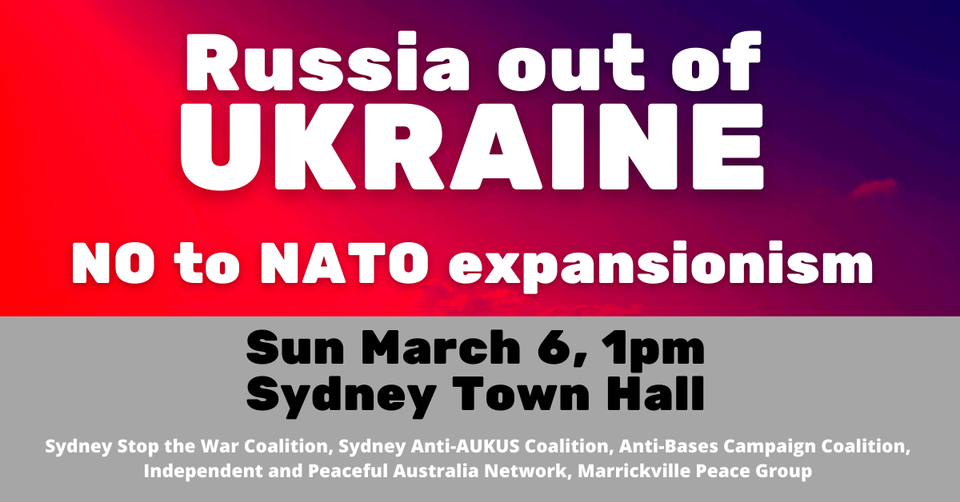
Consider what people in the city would think when they see hundreds of people march by behind a big banner screaming, “Russia Out of Ukraine” (the very small slogan underneath it against NATO expansionism would be almost lost to them). They would conclude: a lot of people agree with Scott Morrison, Peter Dutton and Anthony Albanese about this war. Thus the rally acted in the direction of boosting the authority of Australia’s warmongering ruling class. That can only help them in their drive to use this conflict to intensify their Cold War drive against socialistic China.
Therefore, we urge our readers NOT to participate in any future actions similar to the “Russia Out of Ukraine” action held on March 6. Please also do NOT participate in any other actions mobilised on the basis of support to Ukraine in this war. Instead, do your best to dissuade any of your friends from joining such actions.
In resisting the international agenda of our own imperialists we must learn from Lenin’s Bolsheviks. At the outbreak of World War I there was massive pressure on Russian socialists to support the war efforts of their own rulers. Patriotic fervor was intense. Besides, it was said that Austria-Hungary and its German allies had “started” the war. The Bolsheviks insisted that it does not matter who “starts” the war – this is a reactionary war between rival imperialist powers. They called to turn the inter-imperialist war into a class war against the capitalist rulers of each of the warring parties. The main enemy is at home, they insisted. Their stance provoked outrage in Russia. The Bolsheviks faced much, much more pressure to adapt to the war agenda of their own rulers than we face today. Workers who had bought the propaganda violently attacked the Bolsheviks in the factories, hurling bits of metal at them to drive them out. Not only did the Bolsheviks lose a lot of support, many of their own weaker members quit the movement. Meanwhile, leading members of the party were arrested, convicted of high treason and banished to Siberia. Yet the party stuck to the line that they knew was correct. Eventually, as the war progressed and the terrible suffering that it caused became evident, workers slowly realised that the Bolsheviks had been right all along. That they had stood firm on the unpopular stance that they took at the start of the war later gave the party immense authority amongst the most politically aware sections of the working class. With this authority that came from standing firm in very difficult times, the Bolsheviks were able to lead the workers, poor peasants and oppressed nationalities of Russia to power just three years after they had been harshly ostracised.
Today, we need to build a communist party that will stand firm like Lenin’s Bolsheviks. We fight to advance towards that goal by today insisting that the main enemy of the working class and downtrodden of Australia is not Putin’s capitalist regime but the capitalist rulers of Australia and its U.S. and NATO allies. We stand for building actions that will say: No to sanctions on Russia! Oppose U.S. and Australian arms grants to Ukraine! Down with NATO! No to escalation of the Cold War drive against socialistic China! No nuclear submarines for the Australian military! Stand with socialistic China to stand by working class interests!
If we take such a firm stand against our own capitalist exploiters, then we may well help inspire leftists and workers in Ukraine and Russia to oppose the war drive of each of their own respective capitalist rulers and wage class war against these oppressors.
